This is the multi-page printable view of this section. Click here to print...
Data Sheets
- 1: TWELITE
- 1.1: TWELITE BLUE / RED Wireless Microcontroller
- 1.2: TWELITE (GOLD Series)
- 1.2.1: TWELITE (GOLD Series)
- 1.2.2: TWELITE (GOLD Series)
- 2: TWELITE DIP
- 3: TWELITE PAL
- 3.1: BLUE PAL / RED PAL
- 3.2: Open-Close Sensor PAL
- 3.3: Environmental Sensor PAL
- 3.4: Motion Sensor PAL
- 3.5: Notification PAL
- 3.6: Dedicated Case for PAL
- 4: TWELITE CUE
- 5: TWELITE ARIA
- 6: TWELITE STICK
- 6.1: TWELITE STICK
- 6.1.1: TWELITE STICK Datasheet
- 7: TWELITE UART Datasheet
- 8: MONOSTICK
- 8.1: MONOSTICK BLUE / RED
- 8.1.1: MONOSTICK Data Sheet
- 9: TWELITE R
- 9.1: TWELITE R2
- 9.1.1: TWELITE R2 Datasheet
- 9.2: TWELITE R3
- 9.2.1: TWELITE R3 Datasheet
- 10: TWELITE STAGE
- 10.1: TWELITE STAGE HAT
- 10.1.1: TWELITE STAGE HAT Datasheet
- 11: TWELITE SPOT
- 11.1: TWELITE SPOT Datasheet
- 11.1.1: TWELITE SPOT Datasheet
- 12: Energy Harvesting Modules
- 12.1: TWE-EH SOLAR
- 12.1.1: TWE-EH SOLAR
- 13: Antennas
- 13.1: Inverted-F PCB Antenna Pattern
- 13.2: Matchstick Antenna
- 13.2.1: Matchstick Antenna Data Sheet
- 13.2.2: Matchstick Antenna Data Sheet
- 13.3: Key-Shaped Antenna
- 13.3.1: Key-Shaped Antenna Data Sheet
- 13.4: Hook-Shaped Antenna
- 13.4.1: Hook-Shaped Antenna Data Sheet
- 13.5: Internal Embedded Planar Antenna
- 13.6: Internal Embedded Planar Antenna
- 13.7: Internal Embedded Planar Antenna
- 13.8: Internal Embedded Planar Antenna
- 13.8.1: 筐体内組込み型平面アンテナ データシート
- 13.9: Indoor Foldable Antenna
- 13.10: Waterproof Foldable Antenna (114)
- 13.11: Waterproof Foldable Antenna (123)
- 13.12: Dual-Polarized Patch Antenna
- 13.13: SMA Conversion Cable
- 13.13.1: SMA Conversion Cable Data Sheet
- 13.14: SMA Cable
- 13.14.1: SMA Cable Data Sheet
- 13.15: SMA Cable
- 13.15.1: SMA Cable Data Sheet
- 14: Discontinued Products
- 14.1: TWELITE STAGE
- 14.1.1: TWELITE STAGE BOARD
- 14.1.1.1: TWELITE STAGE BOARD Data Sheet
- 14.2: TWELITE 2525A
- 14.2.1: TWELITE 2525A
- 14.2.1.1: TWELITE 2525A Data Sheet
1 - TWELITE
TWELITE is a microcontroller module with wireless functionality.
By mounting it on a parent board connected to sensors, switches, LEDs, etc., you can build compact wireless devices.
It consumes very little power and can operate for long periods on batteries.
It is suitable for mass production due to its surface-mount compatibility with automated assembly machines.
1.1 - TWELITE BLUE / RED Wireless Microcontroller
1.1.1 - TWELITE Wireless Microcontroller Datasheet
Features
- Compliant with the global IEEE802.15.4 standard
- Supports our proprietary protocol stack “TWELITE NET”
- Ultra-compact module (13.97 × 13.97 × 2.5 mm)
- PCB design maximizes chip performance for stable long-range communication
- Equipped with 32KB RAM and 160KB/512KB flash memory, enabling high-performance communication applications
- Extremely low standby current of 0.1μA (RAMOFF sleep), extending battery life
- Rich I/O including 4 or 6 ADCs, 1 comparator, and 20 general-purpose I/O ports for direct sensor connection
- On-board flash memory allows firmware updates
- Firmware development supported by free GNU and Eclipse-based environments
- Robust 128-bit AES encryption ensures security
- Certified under Japan’s ARIB STD-T66 (Technical Conformity), usable without additional license or application
- RoHS compliant, meeting new environmental standards
Specifications
Product Variants
TWELITE BLUE and TWELITE RED are available in the variations shown below. Please select the most suitable model for your application.
Sales codes may change over time. Please refer to our website for the latest sales codes.
| Common Name | Sales Code | Antenna Terminal | Notes |
|---|---|---|---|
| TWELITE BLUE | TWE-L-WX | Wire antenna terminal type | Antenna not included (reel only) |
| TWE-L-U | Coaxial antenna type | Antenna not included | |
| TWELITE RED | MW-R-WX | Wire antenna terminal type | Antenna not included |
| MW-R-U | Coaxial antenna type | Antenna not included |
Wireless Section
| TWELITEBLUE | TWELITERED | Notes | |
|---|---|---|---|
| Communication Method | 2.4GHzIEEE 802.15.4 compliant | 2.4GHzIEEE 802.15.4 compliant | |
| Protocol Stack | TWELITE NET andIEEE 802.15.4 MAC | TWELITE NET andIEEE 802.15.4 MAC | |
| Data Rate | Up to 250kbps | Up to 250kbps | |
| Modulation | O-QPSK, DSSS | O-QPSK, DSSS | |
| Number of Channels | 16 | 16 | May vary by country |
| TX Output Power | 2.5dBm | 9.19dBm | 25°C, 3V |
| RX Sensitivity | -95dBm | -96dBm | 25°C, 3V, typ |
| TX Current | 15.3mA | 23.3mA | 25°C, 3V, typ at max output |
| 14.0mA | At 3dBm output | ||
| RX Current | 17.0mA | 14.7mA | 25°C, 3V, typ |
Microcontroller Section
- 32-bit RISC processor
- Variable clock for power optimization
- RAM: 32kBytes
- EEPROM: 4kBytes
- Flash memory: 160kBytes (TWELITE BLUE) / 512kBytes (TWELITE RED)
- Watchdog timer, brown-out detection
- Fine-grained power control for each block (digital/analog/RAM/wireless)
- Built-in AES 128-bit encryption circuit and 16-bit random number generator
Interfaces
| Qty | Notes | |
|---|---|---|
| ADC | 4/6 | 10-bit. 4 ports for TWELITE BLUE, 6 ports for TWELITE RED |
| PWM | 4 | |
| Timer/PWM | 1 | 5 modes including PWM, Δ∑. 16MHz, 16-bit resolution |
| Pulse Counter | 2 | Operates in sleep mode. Max 100kHz, 16-bit |
| UART | 2 | 16550A compatible |
| SPIMaster/Slave | 1 | 3 chip selects, up to 16MHz |
| Comparator | 1 | |
| 2-wire SerialMaster/Slave(I2C, SMBUS compatible) | 1 | Up to 100kHz or 400kHz, 7/10-bit address modes |
| General-purpose Digital | 20 | Shared with other interfaces |
- Many pins are shared; some combinations may not be available simultaneously.
Certifications and Compliance
| TWELITE BLUE | TWELITE RED | |
|---|---|---|
| Certification Model | TWE-001 Lite | TWELITE RED |
| Technical Conformity Number | 007-AB0031 | 007-AF0062 |
| FCC ID | 2AINN-L1 | - |
| IC ID | 21544-L1 | - |
| Notes | RoHS compliant | RoHS compliant |
※1. When using TWELITE outside Japan, there may be restrictions on antennas and other components. Please consult us at the early stage of your development.
※2. Depending on the country, it may be necessary to display the FCC ID or IC ID on TWELITE or your product. If applicable, please contact us.
Export Precautions
- The built-in AES 128-bit encryption circuit in TWELITE is subject to export control. We will issue an export control statement as needed; please contact us when exporting.
- In some countries, customs clearance may not be possible unless TWELITE has obtained local radio certification. Please inquire about regulations for each export destination.
Product Labeling
The product is marked with a logo, certification numbers, etc., which are subject to change without notice.
Block Diagram
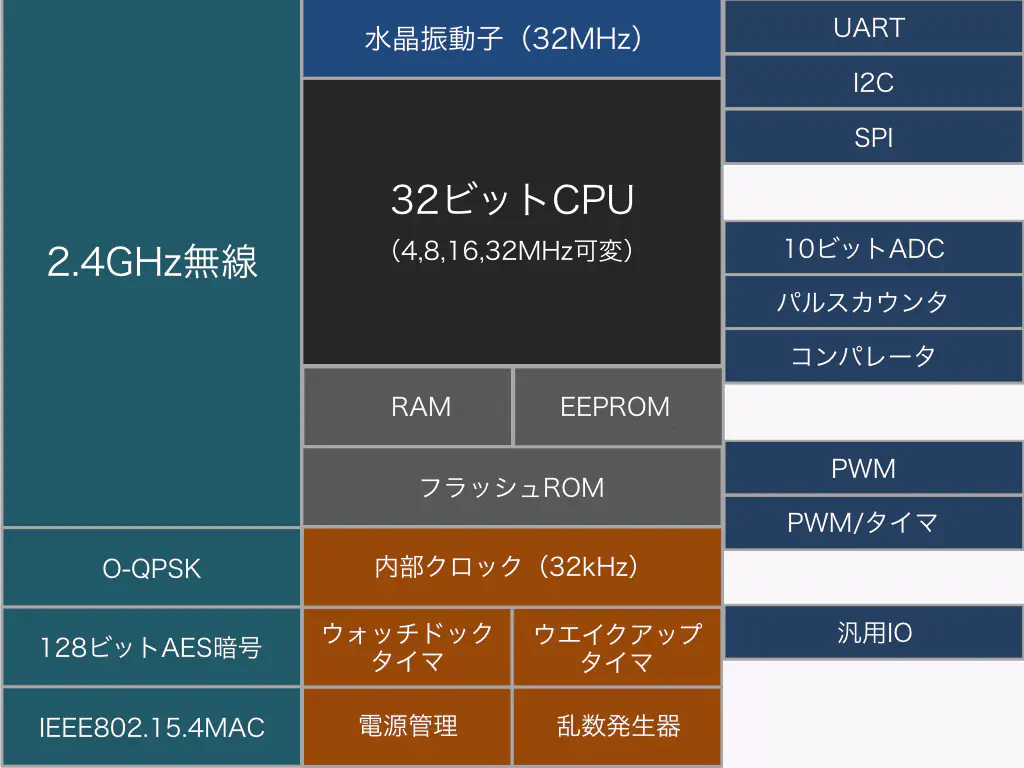
External Dimensions
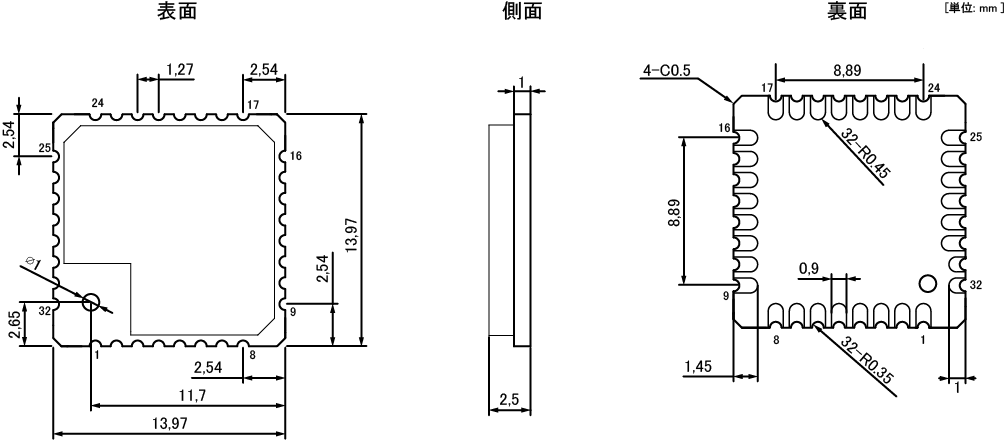
Dimensions: 13.97 × 13.97 × 2.5 mm Weight: 0.93 g
DXF data for TWELITE BLUE/TWELITE RED outlines is available for download from our website.
Recommended Pad Dimensions

- The mating PCB contacting the module’s underside must not have silkscreen or through-holes.
- When soldering a wire antenna (such as a matchstick antenna), provide a rectangular hole in the mating PCB and solder from the underside of the module. (See Chapter 7 for details.)
- Use a metal mask thickness in the range of t=0.12–0.15mm. Depending on the mask and reflow conditions, solder fillets may not form on one side of the module’s half-through-holes.
Antenna Mounting Opening
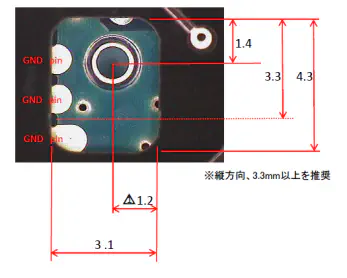
When mounting TWELITE on your custom PCB, it is efficient to provide an opening for connecting a wire antenna (matchstick antenna) and solder from the underside.
This drawing shows an example of such an opening.
In this example, pins 29, 30, 31, and 32 (NC, GND, GND, GND) are left unconnected to allow for a larger opening.
Note: Connecting GND pins 28, 30–32 on the SMD version is recommended, but operation without connection is also possible. No significant change in wireless performance has been observed even if left unconnected.
Pin Assignment
Pin Numbers
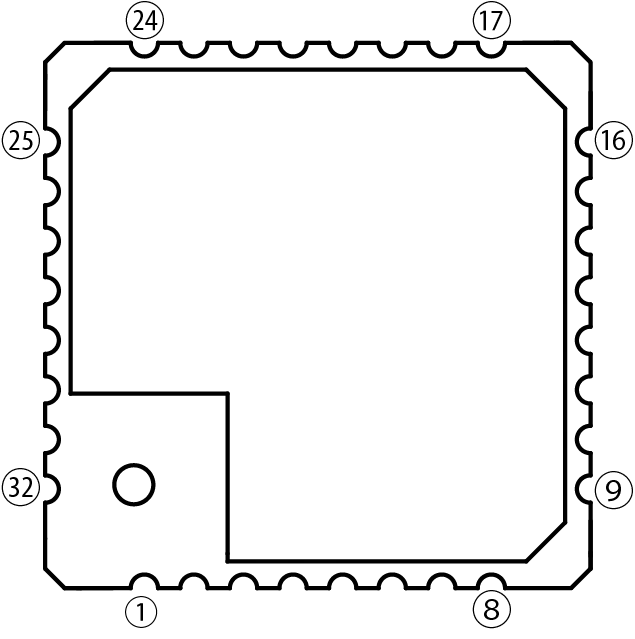
Pin Assignment
| # (Note 1) | IO Name (Note 2) | Function Assignment (Note 3) | Alternate Assignment (Note 4) | Super Easy! Standard App Function Name (Note 5) | ||||
|---|---|---|---|---|---|---|---|---|
| 1 | DO0 | SPICLK | PWM2(※6) | PWM2 | ||||
| 2 | DO1 | SPIMISO | PWM3(※6) | PWM3 | ||||
| 3 | DIO18 | SPIMOSI | DO1 | |||||
| 4 | DIO19 | SPISEL0 | DO2 | |||||
| 5 | VCC | VCC | VCC | |||||
| 6 | DIO4 | CTS0 | TIM0OUT | PC0 | DO3 | |||
| 7 | DIO5 | RTS0 | PWM1 | PC1 | PWM1 | |||
| 8 | DIO6 | TXD0 | PWM2 | TX | ||||
| 9 | DIO7 | RXD0 | PWM3 | RX | ||||
| 10 | DIO8 | TIM0CK_GT | PC1 | PWM4 | PWM4 | |||
| 11 | DIO9 | TIM0CAP | 32KTALIN | RXD1 | DO4 | |||
| 12 | DIO10 | TIM0OUT | 32KTALOUT | M1 | ||||
| 13 | DIO12 | PWM2 | CTS0 | DI1 | ||||
| 14 | DIO14 | SIF_CLK | TXD1 | TXD0 | SPISEL1 | SCL | ||
| 15 | DIO13 | PWM3 | RTS0 | DI2 | ||||
| 16 | DIO11 | PWM1 | TXD1 | DI3 | ||||
| 17 | DIO15 | SIF_D | RXD1 | RXD0 | SPISEL2 | SDA | ||
| 18 | DIO16 | COMP1P | SIF_CLk | DI4 | ||||
| 19 | DIO17 | COMP1M | PWM4 | SIF_D | BPS | |||
| 20 | GND | GND | ||||||
| 21 | RESETN | RESETN | RST | |||||
| 22 | ADC2 | VREF | AI3 | |||||
| 23 | ADC1 | AI1 | ||||||
| 24 | DIO0 | SPISEL1 | ADC3 | AI2 | ||||
| 25 | DIO1 | SPISEL2 | ADC4 | PC0 | AI4 | |||
| 26 | DIO2 | ADC5(※7) | TIM0CK_GT | M2 | ||||
| 27 | DIO3 | ADC6(※7) | TIM0CAP | M3 | ||||
| 28 | GND | GND | GND | |||||
| 29 | NC | RF | N/A | |||||
| 30 | GND | GND | GND | |||||
| 31 | GND | GND | GND | |||||
| 32 | GND | GND | GND |
Note 1. Pin number. Note that the number and assignment may differ from TWELITE DIP. IO name is usually used to identify pins. Note 2. IO name. This is used in semiconductor datasheets, TWELITE app development, and technical support. Note 3. Each pin can be used as simple I/O or analog input, but can also be initialized for other functions via API. The table lists typical functions. Note 4. Alternate functions assignable via API. The table lists typical alternate functions. Note 5. Pin names used by the “Super Easy! Standard App (App_Twelite)”. These are similar to IO names but take care to avoid confusion. Note 6. PWM2,3 can be assigned to DO0,1 by releasing DIO6,7 or DIO12,13 assignments. Note 7. ADC5,6 are available only on TWELITE RED.
Function Reference
| Signal Name | Function |
|---|---|
| PC | Pulse Counter |
| SPICLK | SPI Master Clock |
| SPISEL | SPI Select Output |
| SPIMISO | SPI Master Input |
| SPIMOSI | SPI Master Output |
| TIM0CK_GT | Timer Clock, Gate Input |
| TIM0CAP | Timer Capture Input |
| TIM0OUT | Timer PWM Output |
| 32KTALIN | Crystal Input |
| 32KTALOUT | Crystal Output |
| VREF | Reference Voltage |
| COMP1M | Comparator + Input |
| COMP1P | Comparator - Input |
| SIF_D | 2-wire Serial Data |
| SIF_CLK | 2-wire Serial Clock |
| RXD | UART RX |
| TXD | UART TX |
| RTS | UART RTS |
| CTS | UART CTS |
| PWM | Pulse Width Modulation Output |
Special Pin Handling
DO0 (Function: SPICLK)
This pin is used as an output.
If an external voltage is applied
(even with some output impedance), there have been reports that the TWE module may fail to enter programming mode.
When connecting LEDs or transistors, the pin may enter an intermediate state at startup or wakeup from sleep, possibly causing malfunction. Always use an external circuit that pulls up to Vcc.
DO1 (Function: SPIMISO)
This pin is typically used as an output, but at power-on or reset, it behaves as an input. If a low level is detected at this time, the module boots in programming mode. Pay attention to the voltage at startup on this pin.
DIO0 (Function: ADC3), DIO1 (Function: ADC4)
These pins are shared with analog input. In firmware, the internal pull-up must be disabled when reading AD values .
ADC2
ADC2 can be used as a reference voltage input. Software implementation is required. There is no pin for outputting the reference voltage.
GND
Connecting GND pins 28, 30–32 on the SMD version is recommended, but operation without connection is possible. No significant change in wireless performance has been observed even if left unconnected.
Absolute Maximum Ratings
| Min | Max | ||
|---|---|---|---|
| Power Supply (VCC) | -0.3 | 3.6 | V |
| Analog IO (VREF/ADC) | -0.3 | VCC+0.3 | V |
| Digital IO | -0.3 | VCC+0.3 | V |
Characteristics
Recommended Operating Conditions
| Symbol | Condition | min | typ | max | ||||
|---|---|---|---|---|---|---|---|---|
| Power Supply Voltage | VCC | 2.0 | 3.0 | 3.6 | V | |||
| Startup Voltage | Vboot | 2.05 | V | |||||
| Operating Temperature | TOPR | No condensation | TWELITE BLUE | -40 | 25 | 105(Note 1) 90(Note 2) | °C | |
| TWELITE RED | -30 | 25 | 90 | |||||
| Operating Humidity | HOPR | No condensation | 85 | %RH |
*Values are based on semiconductor datasheets.
Note 1: Maximum operating temperature for TWE-L-WX/W0/W7
Note 2: Maximum operating temperature for TWE-L-U
DC Characteristics
| Symbol | Condition | min | typ | max | |||
|---|---|---|---|---|---|---|---|
| Current Consumption | ICC | Sleep (RAMOFF, no timer) | TWELITE BLUE | 0.1 | uA | ||
| TWELITE RED | 0.1 | uA | |||||
| Sleep (with timer) | TWELITE BLUE | 1.5 | uA | ||||
| TWELITE RED | 1.5 | uA | |||||
| Tx (CPU doze) | TWELITE BLUE | 15.3 | mA | ||||
| TWELITE RED | 23.3 | mA | |||||
| TWELITE RED(at 3dBm output) | 14.0 | mA | |||||
| Rx (CPU doze) | TWELITE BLUE | 17.0 | mA | ||||
| TWELITE RED | 14.7 | mA | |||||
| TX Output Power | Pout | TWELITE BLUE | +0.5 | 2.5 | dBm | ||
| TWELITE RED | 9.14 | dBm | |||||
| RX Sensitivity | TWELITE BLUE | -95 | dBm | ||||
| TWELITE RED | -96 | dBm |
*Values are based on semiconductor datasheets.
I/O Characteristics
| Symbol | Condition | min | typ | max | ||
|---|---|---|---|---|---|---|
| DIO Internal Pull-up | 40 | 50 | 60 | kΩ | ||
| DIO Hi Input | VIH | VCCx0.7 | VCC | V | ||
| DIO Lo Input | VIL | -0.3 | VCCx0.27 | V | ||
| DIO Input Hysteresis | 200 | 310 | 400 | mV | ||
| DIO Hi Output | VOH | TWELITE BLUE | VCCx0.8 | VCC | V | |
| TWELITE RED | VCC-0.4 | |||||
| DIO Lo Output | VOL | 0 | 0.4 | V | ||
| DIO Sink Current | IOL | VCC 2.7–3.6V | 4 | mA | ||
| VCC 2.2–2.7V | 3 | mA | ||||
| VCC 2.0–2.2V | 2.5 | mA |
*Values are based on semiconductor datasheets.
ADC Characteristics
| Symbol | Condition | min | typ | max | ||
|---|---|---|---|---|---|---|
| Reference Voltage | VREF | 1.198 | 1.235 | 1.260 | V | |
| ADC Resolution | 10 | Bits | ||||
| ADC Integral Nonlinearity | ±1.6, ±1.8 | LSB | ||||
| ADC Differential Nonlinearity | -0.5 | 0.5 | LSB | |||
| ADC Offset Error | 0–VREF | -10 | mV | |||
| 0–2VREF | -20 | |||||
| ADC Gain Error | TWELITE BLUE0–VREF | +10 | mV | |||
| TWELITE BLUE0–2VREF | +20 | |||||
| TWELITE RED0–VREF | -10 | |||||
| TWELITE RED0–2VREF | -20 | |||||
| ADC Clock | 0.25,0.5, 1.0 | MHz | ||||
| ADC Input Range | 0.04 | VREF2xVREF | V |
*Values are based on semiconductor datasheets.
Reel Specifications
Taping Dimensions
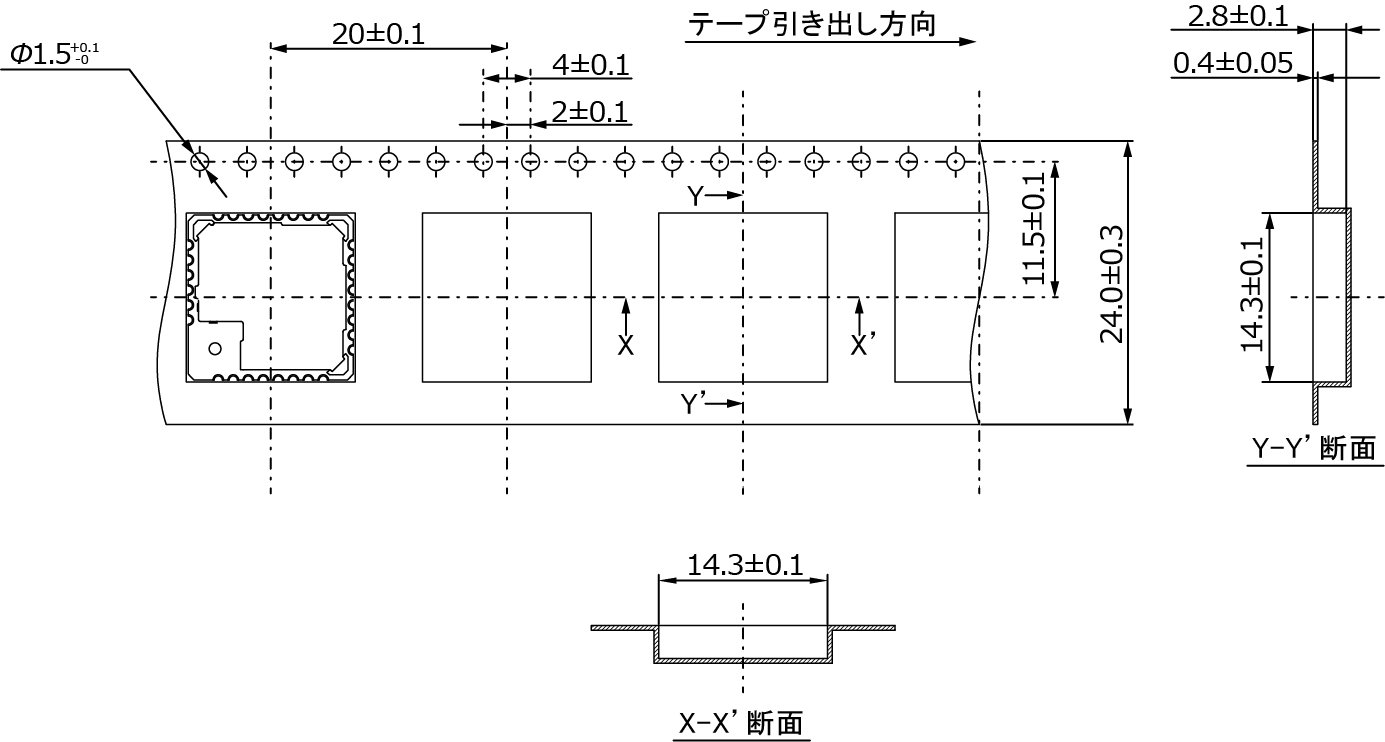
Reel Dimensions

Maximum Module Packaging Quantity
| Reel/Inner Box | Quantity/Reel | Outer Box | Quantity |
|---|---|---|---|
| 1 | 1000 | 1 | 1000 |
Reflow Conditions
Recommended Reflow Profile
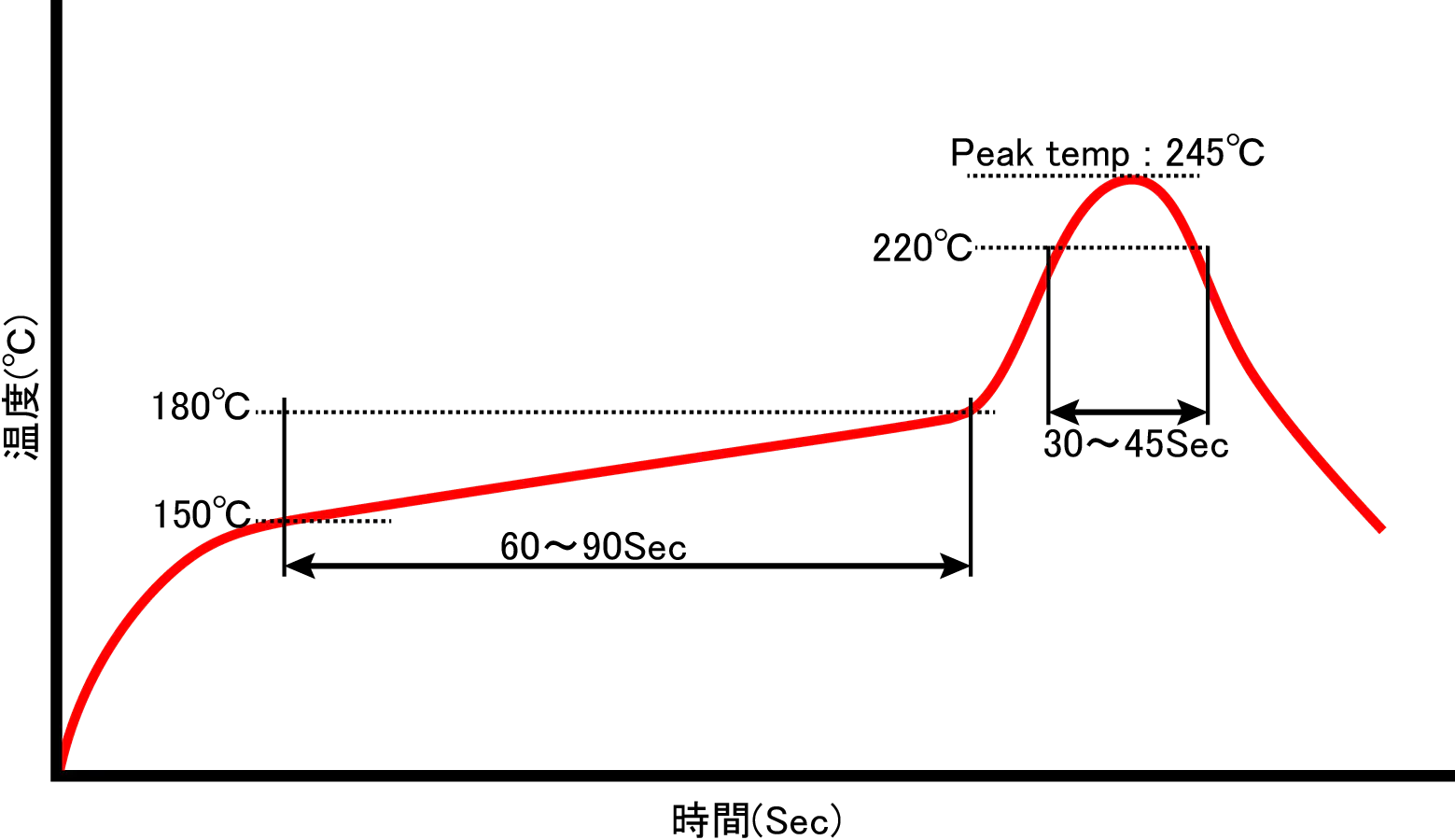
Reflow profile
| Preheating | Main Heating | Peak Temp | Number of Reflows |
|---|---|---|---|
| 150 | 220°C/30~45sec | 245°C | 1 time |
- Temperature conditions: One reflow within the recommended temperature profile above.
- Soldering should be performed by reflow soldering as a general rule.
- We have confirmed no issues under the above profile, but please verify solderability under your own manufacturing conditions.
Board Mounting Precautions
- Only one reflow process is allowed under our recommended conditions. Note that solder inside the module will re-melt during reflow. Reflow soldering is the principle method.
- The product absorbs moisture if left in the natural environment. Mount using reflow within 72 hours after opening.
- When storing below the above humidity, ensure proper anti-static measures.
- If more than 72 hours have passed after opening, bake under the following conditions before use:
- Do not bake reels directly. Transfer to trays, etc., before baking.
- Baking conditions: 90°C, 48 hours, up to 1 time.
- Please note that multiple lot numbers may be mixed in the same package.
- Solder fillets are not required on the soldered parts of components mounted on this product.
- This product is intended for mounting on glass epoxy PCBs. If mounting on other materials (e.g., ceramics), evaluate thoroughly before use.
- Some internal components are highly sensitive to static electricity. Take adequate ESD precautions.
- If stress is applied to the shield case, it may detach. Handle with care.
- For hand soldering, follow these conditions: below 350°C, within 3 seconds (surface temperature must not exceed 150°C).
Precautions for Use
Factory Default Application
At the time of shipment (as of this datasheet’s publication), TWELITE is programmed with the “Super Easy! Standard App” firmware. This firmware is intended for production testing during manufacturing. We cannot disclose information about the firmware version or contents programmed on TWELITE, even upon request. In the future, the presence or type of pre-installed firmware may be changed without notice. Please write the required application to TWELITE during your own manufacturing process.
Storage
Store in a cool, dry place. Use the product within six months of delivery.
General Notes
Always evaluate and verify our products in your actual usage environment.
If you intend to use this product in applications requiring high reliability or involving human life, please consult your distributor in advance.
Revision History
| Version | Date | Revision Details |
|---|---|---|
| 4.0.2 | 2024/11/12 | Corrected current unit error |
| 4.0.1 | 2024/07/12 | Applied sales code changes; antenna column removed |
| 4.0.0 | 2024/02/27 | Migrated to new website |
| 3.0.4 | 2019/1/31 | Added “Factory Default Application” section |
| 3.0.3 | 2018/11/05 | Corrected section number error in Chapter 8 |
| 3.0.2 | 2018/3/7 | Corrected pin function name error in App table |
| 3.0.1 | 2017/9/1 | Corrected TWELITE RED sleep current value |
| 3.0.0 | 2017/8/1 | Initial version |
1.2 - TWELITE (GOLD Series)
1.2.1 - TWELITE (GOLD Series)
Introduction
TWELITE® is a compact, low-power, and high-performance wireless module.
Equipped with an Arm® Cortex®-M4 core, it supports mid-range wireless communication compliant with IEEE802.15.4 and short-range communication compliant with ISO/IEC 14443.
It has obtained domestic radio certification in Japan, enabling rapid productization of wireless systems.
Features
- Ultra-compact package (13.97mm × 13.97mm × 2.5mm)
- Mid-range wireless communication compliant with global standard IEEE802.15.4
- PCB design that maximizes chip performance and ensures stable communication over long distances
- Our proprietary simple protocol stack “TWELITE NET”
- Short-range communication with NFC readers compliant with ISO/IEC 14443
- Widely used Arm Cortex-M4 architecture
- Excellent power-saving performance with minimum standby current of 350nA, contributing to battery life
- Equipped with 152KB SRAM and 640KB flash memory, supporting advanced communication application software
- 6-channel 12-bit ADC and 22 general-purpose digital I/O ports to connect various sensors
- 10-channel PWM output, applicable to LEDs and actuators
- Newly equipped 32-bit real-time clock
- Firmware development environment based on the free GNU Arm Embedded Toolchain
- Strong AES encryption with 128bit / 192bit / 256bit
- Certified under Japan’s ARIB STD-T66 (technical conformity certification)
Product Variants
The TWELITE wireless module (GOLD Series) is available in the following variants. Please select according to your application.
| Product Name | Model Number | Antenna Terminal | Remarks |
|---|---|---|---|
| TWELITE | MW-G-W | Wire antenna terminal(through-hole) | Antenna sold separately |
| MW-G-U | Coaxial antenna terminal(U.FL/IPEX) | Antenna sold separately | |
| TWELITE DIP | MW-G-DIP-P | On-board antenna | |
| MW-G-DIP-U | Coaxial antenna terminal(U.FL/IPEX) | Antenna sold separatelyMain unit is MW-G-W |
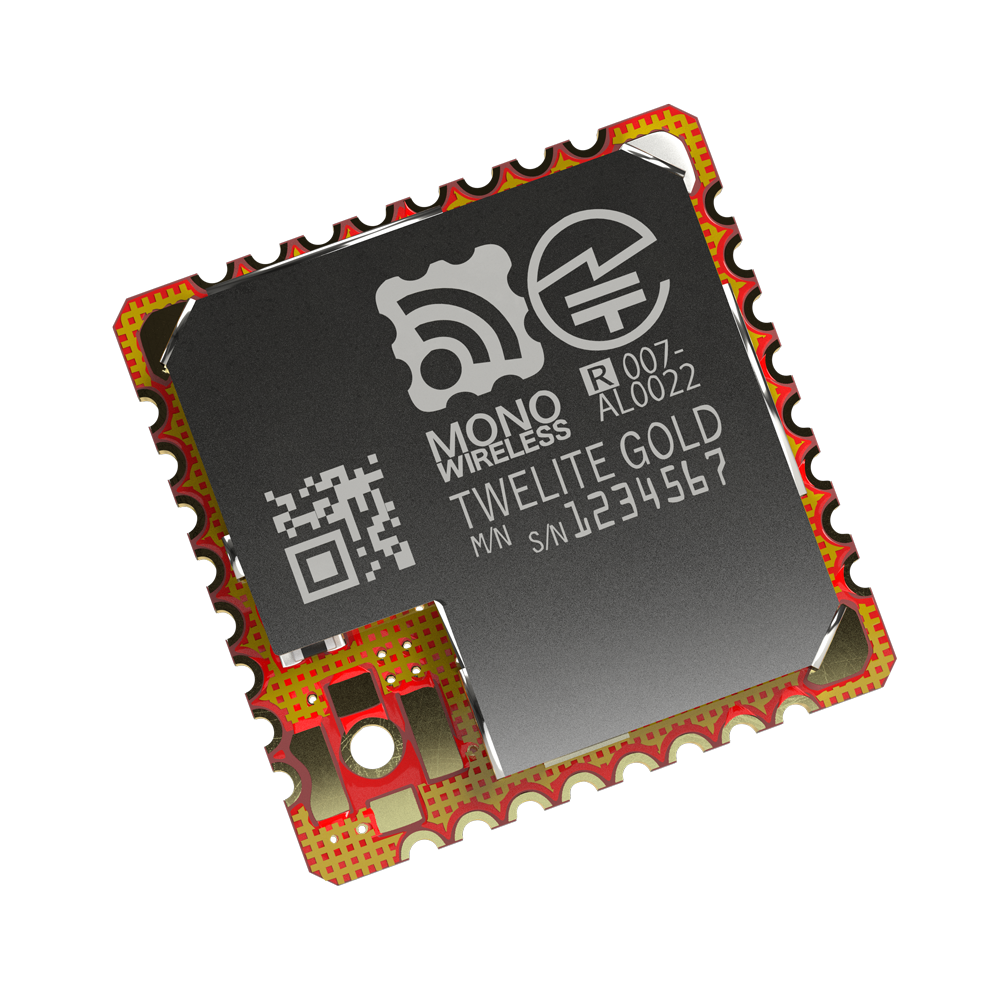
MW-G-W Appearance
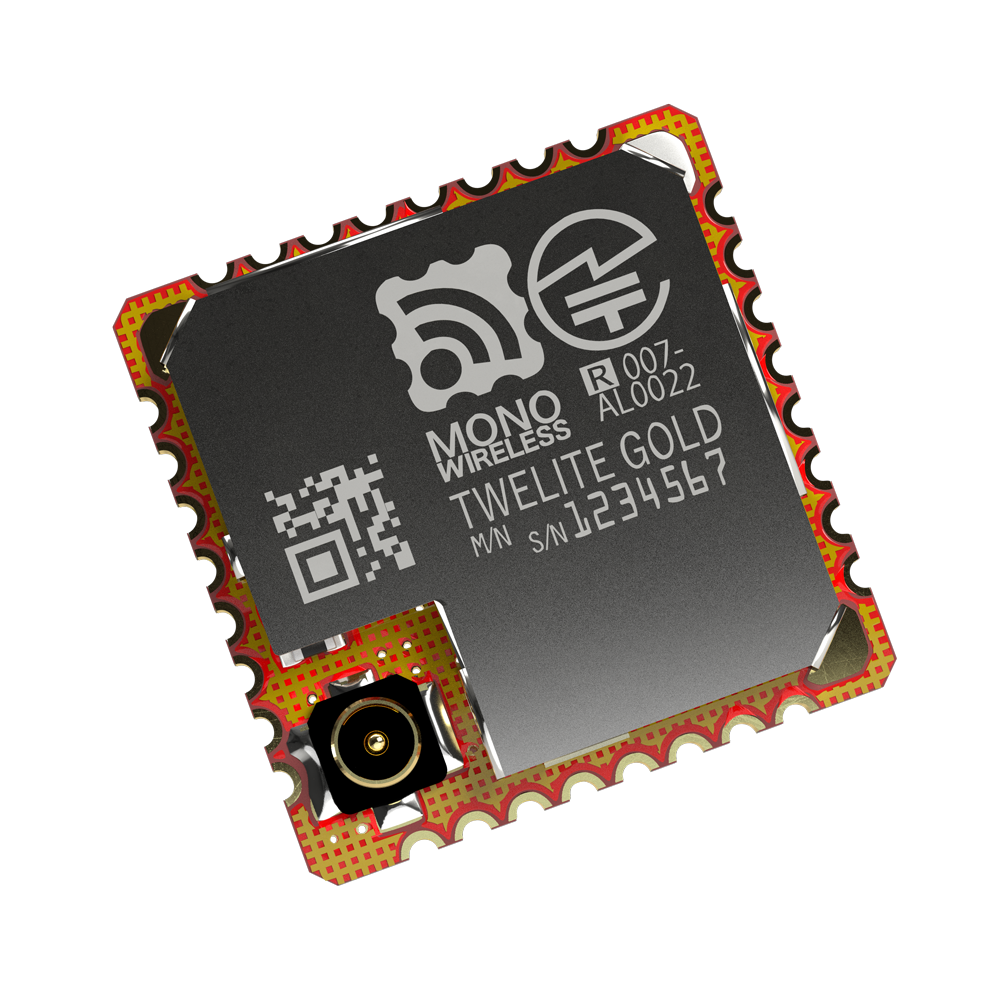
MW-G-U Appearance
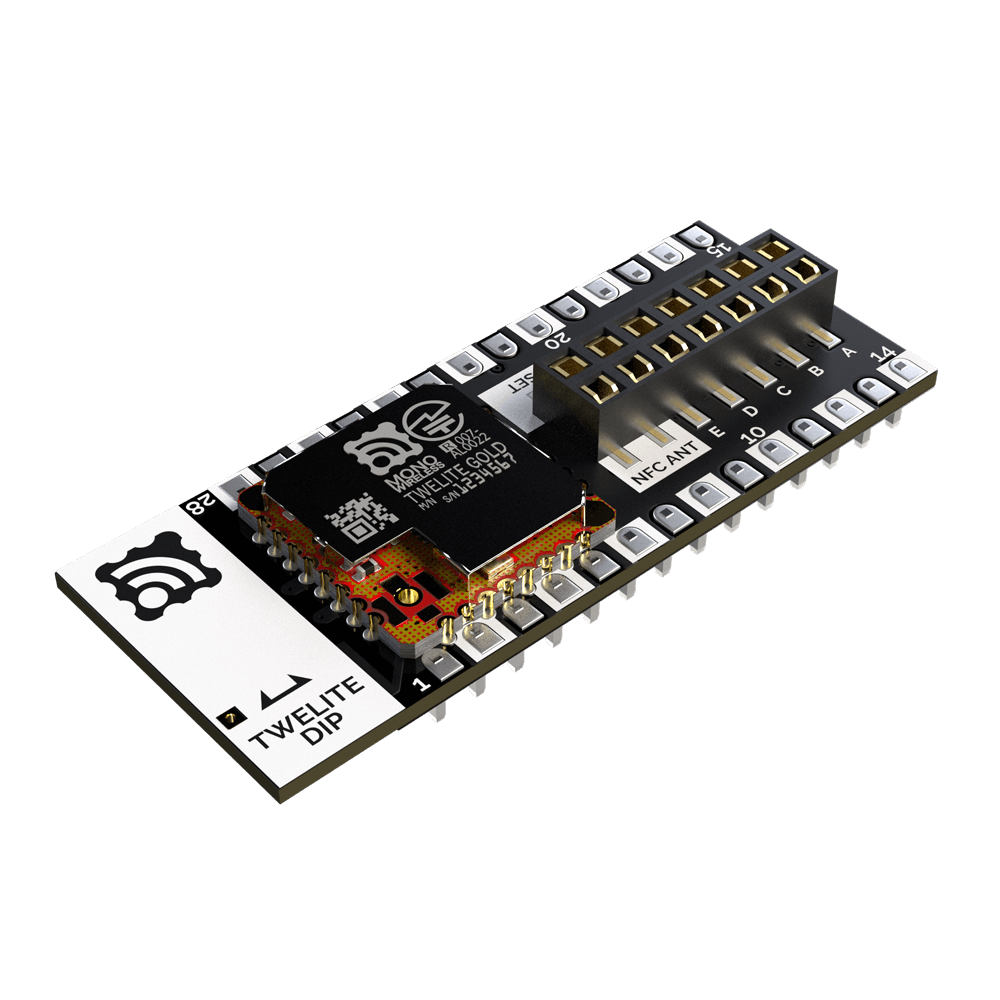
MW-G-DIP-P Appearance
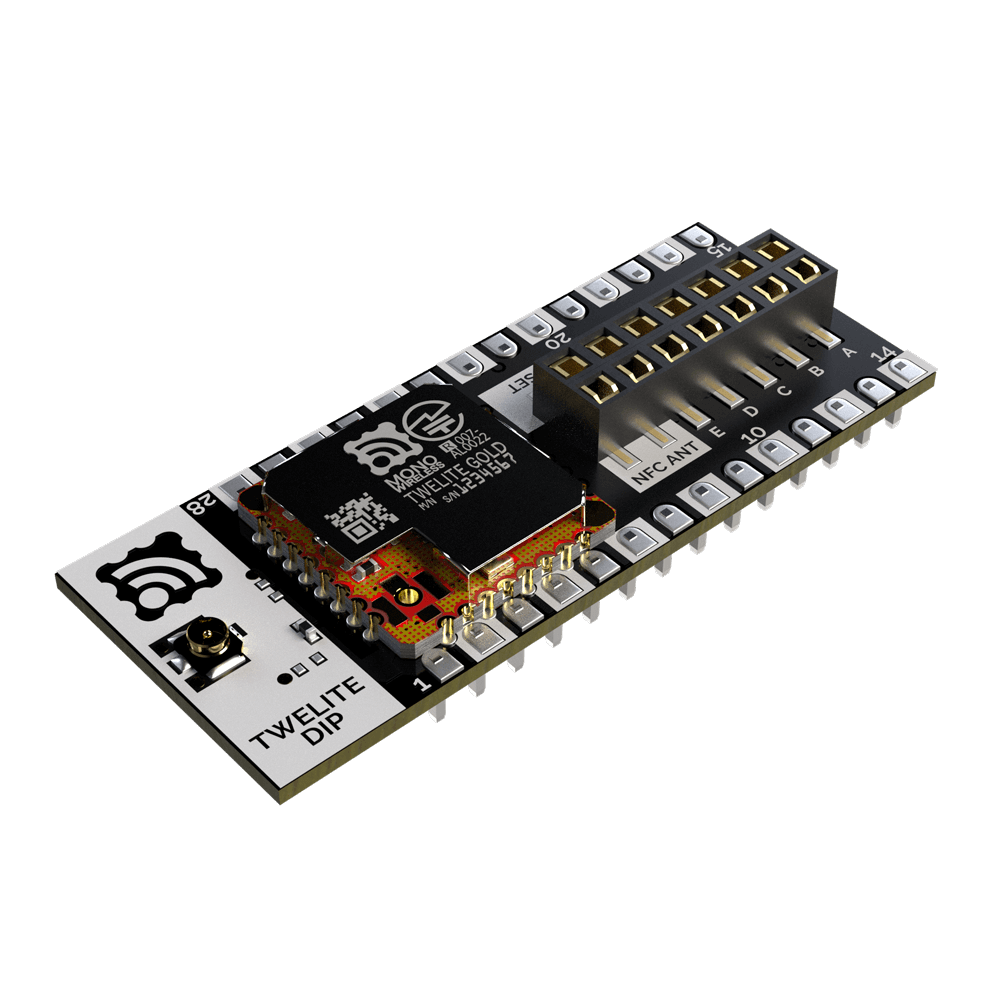
MW-G-DIP-U Appearance
In the following document, the tag SMD indicates sections related to MW-G-W/U, DIP for MW-G-DIP-P/U, and ALL for content relevant to all models.
Functions
ALL- 32-bit Arm Cortex-M4 processor
- Operating clock: 32MHz (clock can be adjusted from 12MHz to 48MHz to optimize power consumption)
- SRAM: 152KB
- Flash memory: 640KB
- EEPROM: 2KB (included in the built-in NFC chip)
- Watchdog timer and brown-out detection
- Power control for each block (digital/analog/SRAM/wireless)
- AES encryption circuit supporting 128bit/192bit/256bit
- 6x ADC (12bit)
- 10x PWM
- 2x Timers (32bit)
- 1x Comparator
- 2x UART
- 2x SPI (3 chip selects)
- 2x I2C
- 22x Digital IO
- 1x Quad SPI
- 1x RTC (32bit)
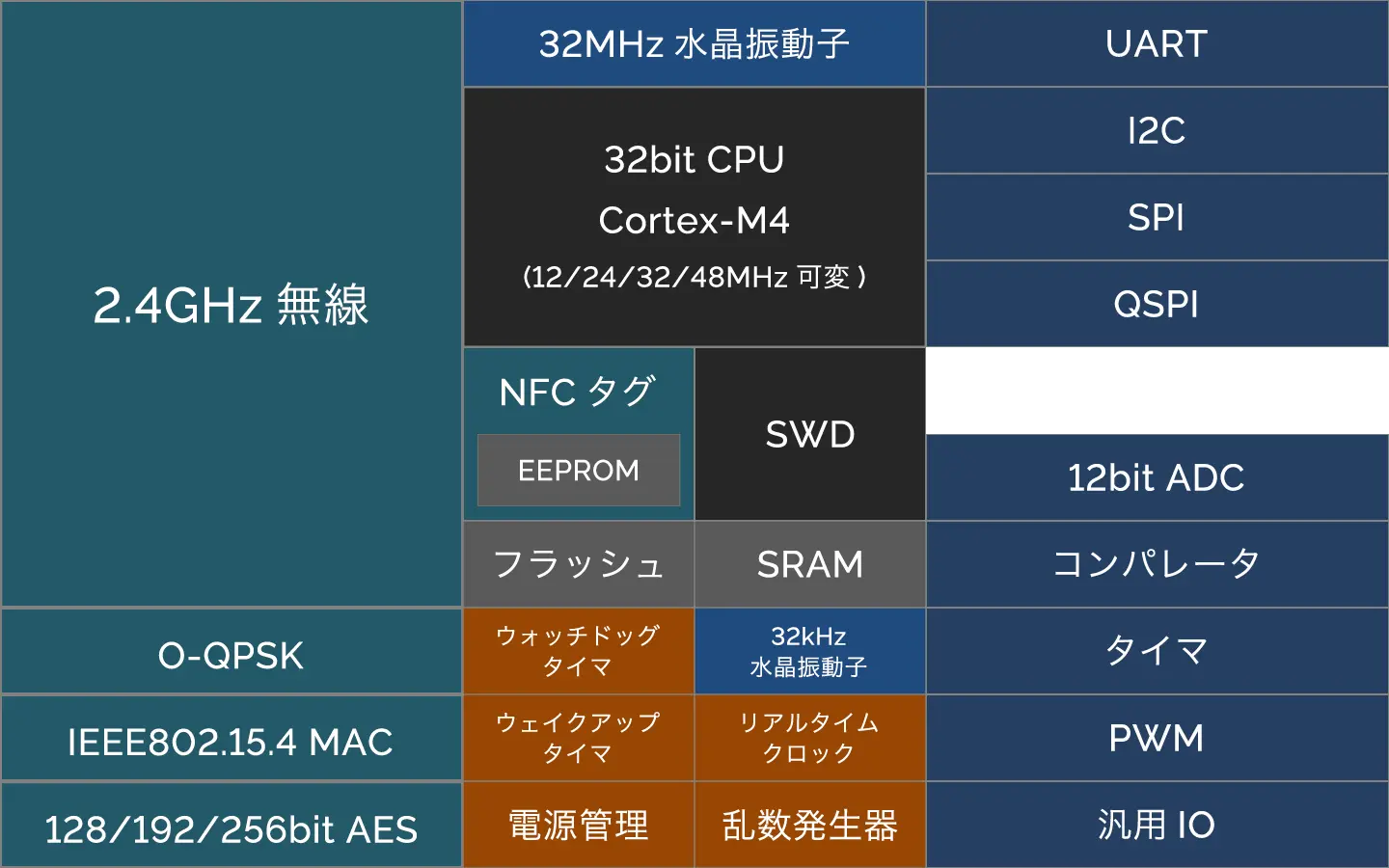
Block Diagram of TWELITE (GOLD Series)
2.4GHz Wireless
ALL| Item | TWELITE (GOLD Series) | Remarks |
|---|---|---|
| Communication | 2.4GHz IEEE 802.15.4 | |
| Protocol | TWELITE NET and IEEE 802.15.4 MAC | |
| Data Rate | 250kbps | |
| Modulation | O-QPSK, DSSS | |
| Channels | 16 | Varies by country |
| Max TX Power | 9.14dBm | 25°C, 3V, typ |
| RX Sensitivity | -99.7dBm | 25°C, 3V, typ |
Antennas
ALLFor a list of compatible antennas, please refer to our product information.
SMDA PCB-mountable antenna MW-A-P1934 is also available.
Certifications
ALL| TWELITE (GOLD Series) | |
|---|---|
| Certification Model | TWELITE GOLD |
| Technical Conformity Certification Number | 007-AL0022 |
When using TWELITE overseas, there may be various restrictions such as on the types of antennas that can be used.
Please contact us during the early stages of development.
NFC Tag
ALL| Item | TWELITE (GOLD Series) | Remarks |
|---|---|---|
| Communication | ISO/IEC 14443 Type A | |
| Protocol | NFC Forum Type 2 Tag | NXP® NTAG® |
| Data Rate | 106kbps | |
| SRAM | 64bytes | |
| EEPROM | 2KB | |
| Write Speed | 4.8ms | 4bytes, EEPROM |
| 0.8ms | 4bytes, SRAM | |
| 6.1ms | 64bytes, SRAM (FAST_WRITE) | |
| Max Distance | 100mm | Depends on antenna configuration |
Development Environment
ALLTWELITE STAGE SDK
TWELITE STAGE SDK is a dedicated firmware development environment for the TWELITE series provided by our company. Using the included application TWELITE STAGE APP, you can build and write firmware, as well as check the operation and change settings of existing firmware.
For usage instructions, refer to the documents included with the TWELITE STAGE SDK.
Documentation on the website may reflect newer versions of TWELITE STAGE SDK and the application, and thus may differ in content from the version you are using.
The TWELITE STAGE SDK consists of the following:
TWELITE STAGE APP (frontend for building, which uses command-line
makefor compilation and performs firmware writing): all exceptMWSDK(Note 1) andToolsunderMWSTAGE/Toolchain (utilities and command-line tools such as compiler): under
MWSTAGE/ToolsMWSDK library (libraries used in builds): under
MWSTAGE/MWSDK(Note 1)
Note 1: The
MWSDKfolder may contain older library versions. In such cases, folder names likeMWSDK20XX_YYare used.The toolchain
gccand the MWSDK library version directly affect the generated binaries.
Distribution of TWELITE STAGE SDK
The TWELITE STAGE SDK for TWELITE GOLD is distributed through our support service.
Below are the major versions currently available:
MWSTAGE2025_08distributed in August 2025- STAGE App:
2.4.4 - Toolchain:
gcc 12.2.1 20221205 - MWSDK Library:
MWSDK2025_08
- STAGE App:
TWELITE GOLD-Specific Development Information
The .../MWSDK/TWENET/current/index.html file under the MWSDK folder contains descriptions about build methods and APIs.
About MCUXpresso
MCUXpresso is a firmware development environment provided by NXP Semiconductors N.V., the manufacturer of the JN5189 semiconductor used in TWELITE (GOLD Series). It allows not only building and writing firmware but also debugging using MCU-Link.
About Software Licensing
When developing firmware using the TWELITE STAGE SDK provided by Mono Wireless Inc., please refer to the license descriptions in the LICENSE folder under the MWSDK library as the primary source. English versions of the licenses are available, but in the event of any dispute or discrepancy, the Japanese version shall take precedence.
MW-SLA-1J— Mono Wireless Software License Agreement (intended for commercial use)MW-OSSLA-1J— Mono Wireless Open Source Software License Agreement (considering non-commercial use)MW-SLA-1E1,MW-OSSLA-1E— English versions of the above
- Refer to the license descriptions included in the source code to understand the applicable license.
- Source code created by Mono Wireless Inc. is generally licensed under either
MW-SLAorMW-OSSLA.
- Source code created by Mono Wireless Inc. is generally licensed under either
- For tool licenses, refer to the distribution directories of the TWELITE STAGE SDK.
- For the TWELITE STAGE APP license, refer to the contents under
MWSTAGE/TWELITE_Stage/LICENSEin the SDK distribution.
- For the TWELITE STAGE APP license, refer to the contents under
Pin Assignment
Pin Number
SMD
Pin Number Assignment

Pin Number Assignment (DIP)
Pin Functions
ALLThe typical functions are shown in the table below.
| Name | Function |
|---|---|
| PIO | Peripheral Input/Output |
| PWM | Pulse Width Modulation Output |
| TXD | UART Data Transmission |
| RXD | UART Data Reception |
| RTS | UART Data Transmission Request Output |
| CTS | UART Data Transmission Request Input |
| SCL | I2C Serial Clock |
| SDA | I2C Serial Data |
| SCK | SPI Serial Clock |
| MOSI | SPI Controller Output (PICO) |
| MISO | SPI Controller Input (POCI) |
| SSELN | SPI Peripheral Select (CS) |
| Name | Function |
|---|---|
| IO | Quad SPI Serial Data |
| CSN | Quad SPI Chip Select |
| CLK | Quad SPI Serial Clock |
| MAT | Timer Output |
| CAP | Timer Input |
| OUT | Comparator Output |
| ACP | Comparator + Input |
| ACM | Comparator - Input |
| SWDIO | SWD Serial Data |
| SWO | SWD Trace Port |
| SWCLK | SWD Serial Clock |
| ISPENT | ISP Entry |
| ISPSEL | ISP Mode Select |
The typical assignments of functions are shown in the table below.
| SMD# Note1 | DIP# (14P) Note1 | IO Note2 | PWM Note3 | ADC Note3 | UART Note3 | I2C Note3 | SPI Note3 | Quad SPI Note3 | Timer (CT32) Note3 | Comparator Note3 | SWD ISP Note3 |
|---|---|---|---|---|---|---|---|---|---|---|---|
| 1 | 6 | PIO0 | PWM0 | TXD1 | SCK1 | ||||||
| 2 | 7(PRG) | PIO5 | RTS0 | SSELN0MISO1SSELN1(2) | ISPENT | ||||||
| 3 | 5 | PIO2 | PWM2 | RXD0 | SCK0MOSI1 | ||||||
| 4 | 8 | PIO3 | PWM3 | TXD0 | MISO0SSELN1(0) | ||||||
| 5 | 28(VCC) | VCC | |||||||||
| 6 | 9 | PIO7 | PWM7 | CTS0RXD1 | SDA1 | MISO0 | CT32B1MAT1 | ||||
| 7 | 4 | PIO6 | PWM6 | RTS0TXD1 | SCL1 | SCK0 | CT32B1MAT0 | ||||
| 8 | 10(TXD) | PIO8 | PWM8 | TXD0 | MOSI0 | CT32B0MAT0 | OUT | ||||
| 9 | 3(RXD) | PIO9 | PWM9 | RXD0 | SSELN0 | CT32B1CAP1 | |||||
| 10 | 11(A) | PIO14 | PWM1 | ADC0 | SSELN1(1) | CT32B0CAP1 | SWO | ||||
| 11 | 12 | PIO12 | PWM0 | SCL1 | MOSI0 | OUT | SWCLK | ||||
| 12 | 13 | PIO4 | PWM4 | CTS0 | MOSI0SSELN1(1) | ISPSEL | |||||
| 13 | 15(SET) | PIO13 | PWM2 | SDA1 | MOSI0 | SWDIO | |||||
| 14 | 2 | PIO10 | TXD1 | SCL0 | SCK0 | CT32B0CAP0 | |||||
| 15 | 16 | PIO1 | PWM1 | RXD1 | MISO1 | ||||||
| 16 | 17 | PIO0 | PWM0 | TXD1 | SCK1 | ||||||
| 17 | 19 | PIO11 | RXD1 | SDA0 | MISO0 | CT32B1CAP0 | |||||
| 18 | 18 | PIO20 | PWM8 | TXD1 | IO2 | ACP | |||||
| 19 | 20 | PIO21 | PWM9 | IO1 | ACM | SWO | |||||
| 20 | 1,14 | GND | |||||||||
| 21 | 21(RST) | RSTN | |||||||||
| 22 | 24(A) | PIO14 | PWM1 | ADC0 | SSELN1(1) | CT32B0CAP1 | SWO | ||||
| 23 | 22(B) | PIO15 | PWM3 | ADC1 | SCL0 | SCK1 | OUT | ||||
| 24 | 23(C) | PIO16 | PWM5 | ADC2 | SDA0 | SSELN1(0) | CSN | ||||
| 25 | 25(D) | PIO17 | PWM6 | ADC3 | MOSI1 | IO3 | SWO | ||||
| 26 | 26(E) | PIO18 | PWM7 | ADC4 | TXD0 | MISO1 | CLK | CT32B0MAT1 | |||
| 27 | 27 | PIO19 | PWM4 | ADC5 | RXD0RXD1 | IO0 | |||||
| 28 | 1,14(GND) | GND | |||||||||
| 29 | N/A(ANT R) | LA | |||||||||
| 30 | 1,14GND | GND | |||||||||
| 31 | N/A(ANT L) | LB | |||||||||
| 32 | 1,14GND | GND |
※1. Pin numbers. The number and assignment of pin numbers differ between TWELITE and TWELITE DIP. Normally, IO names are used to identify pins.
※2. IO names of the pins. These names are used in semiconductor datasheets and TWELITE application development. Our technical support also refers to pins by IO names in principle.
※3. This table lists representative functions. Only a portion of these functions may be supported by the TWENET library.
For compatibility with the TWELITE BLUE/RED series, the following pins are internally connected:
- PIO0: SMD#1 and SMD#16
- PIO14: SMD#10 and SMD#22
It is recommended to connect all GND pins SMD#28, 30, and 32. However, operation without connecting them is also possible.
Even when these pins are left unconnected, no significant change in wireless performance has been observed.
Electrical Characteristics
ALLAbsolute Maximum Ratings
| Min | Max | ||
|---|---|---|---|
| Power Supply | -0.3 | 3.96 | V |
| Reset | -0.3 | 3.96 | V |
| Digital IO | -0.3 | 3.96 | V |
| ADC | -0.3 | 3.96 | V |
| NFC (LA/LB) | -0.3 | 4.6 | V |
- The values are based on the semiconductor datasheet.
Recommended Operating Conditions
| Symbol | Condition | Min | Max | ||
|---|---|---|---|---|---|
| Supply Voltage | VCC | 1.9 | 3.6 | V | |
| Operating Temp | TJ | No condensationMW-G-W | -40 | 105 | °C |
| No condensationMW-G-U | -40 | 90 | °C |
- The values are based on the semiconductor datasheet.
DC Characteristics
| Symbol | Condition | Min | Typ | Max | ||
|---|---|---|---|---|---|---|
| Current Consump. | ICC | Sleep, SRAM not retained, no timer | 350 | nA | ||
| Sleep, SRAM not retained, timer enabled | 800 | nA | ||||
| Sleep, SRAM retained (4KB), timer enabled | 1025 | nA | ||||
| Sleep, SRAM retained (8KB), timer enabled | 1120 | nA | ||||
| Active, TX (10dBm) | 20.28 | mA | ||||
| Active, TX (3dBm) | 9.44 | mA | ||||
| Active, TX (0dBm) | 7.36 | mA | ||||
| Active, RX | 4.3 | mA |
- The values are based on the semiconductor datasheet.
I/O Characteristics
| Symbol | Condition | Min | Typ | Max | ||
|---|---|---|---|---|---|---|
| PIO Internal Pull-up | Rpu(int)(PIO) | 40 | 50 | 60 | kΩ | |
| RSTN Internal Pull-up | Rpu(int)(RSTN) | 40 | 50 | 60 | kΩ | |
| PIO Internal Pull-down | Rpdn(int)(PIO) | 40 | 50 | 60 | kΩ | |
| IO High Input | VIH | 0.7*VCC | VCC | V | ||
| IO Low Input | VIL | -0.3 | 0.27*VCC | V | ||
| IO High Output | VOH | PIO0-9,12-162mA load (VCC=3.6V) | 3.3 | VCC | V | |
| PIO0-9,12-162mA load (VCC=3.0V) | 2.65 | VCC | V | |||
| PIO0-9,12-162mA load (VCC=2.4V) | 2 | VCC | V | |||
| PIO0-9,12-162mA load (VCC=1.9V) | 1.4 | VCC | V | |||
| PIO17-215mA load (VCC=3.6V) | 3.2 | VCC | V | |||
| PIO17-215mA load (VCC=3.0V) | 2.6 | VCC | V | |||
| PIO17-215mA load (VCC=2.4V) | 2.05 | VCC | V | |||
| PIO17-215mA load (VCC=1.9V) | 1.35 | VCC | V | |||
| PIO10,112mA load (VCC=3.6V) | 3.3 | VCC | V | |||
| PIO10,112mA load (VCC=3.0V) | 2.66 | VCC | V | |||
| PIO10,112mA load (VCC=2.4V) | 2.1 | VCC | V | |||
| PIO10,112mA load (VCC=1.9V) | 1.15 | VCC | V | |||
| IO Low Output | VOL | 0 | 0.4 | V |
- The values are based on the semiconductor datasheet.
ADC Characteristics
| Symbol | Condition | Min | Typ | Max | ||
|---|---|---|---|---|---|---|
| Input Voltage | Vi | 0 | VCC | V | ||
| Full Scale Range | FSR | After calibration | 3.56 | 3.6 | 3.62 | V |
| Resolution | 12 | bits | ||||
| Current Consumption | IADCx | x=05 | 100 | uA | ||
| Integral Nonlinearity | INL | 1.1 | LSB | |||
| Differential Nonlinearity | DNL | 0.85 | LSB | |||
| Offset Error | EO | After calibration | -4.5 | 4.5 | mV | |
| Gain Error | EG | After calibration | -40 | 0 | 20 | mV |
| Sampling Frequency | fs | Single channel | 78.4 | 100 | 190 | ksps |
- The values are based on the semiconductor datasheet.
Mechanical Characteristics
External Dimensions
SMD
Outline Drawing
- Dimensions: 13.97mm x 13.97mm x 2.5mm
- Weight: 0.84g (MW-G-W), 0.86g (MW-G-U)

Outline Drawing (Board Antenna)

Outline Drawing (U.FL)
- Dimensions: 44.7mm x 18.3mm x 8.1mm
- Weight: 3.81g (MW-G-DIP-P), 3.83g (MW-G-DIP-U)
Recommended Pad Dimensions
SMD
- Do not place silkscreen or through-holes on the receiving PCB area that contacts the module underside.
- When connecting a wire antenna such as a stick antenna, provide a slot on the receiving PCB and solder from the underside of the module. (See Antenna Opening)
- Use a metal mask thickness in the range of t = 0.12–0.15mm. Due to the metal mask and reflow conditions, solder fillets may not form on some half-cut vias on one side of the module.
Environmental Regulations
- Compliant with RoHS (10 substances)
Shield Can
The shield can is soldered at two diagonal points.
Antenna Opening
SMDWhen mounting TWELITE to a custom PCB and using a wire antenna such as a stick antenna, create an opening on the board and solder from the underside.
The figure below shows an example opening.

In this example, pins 29, 30, 31, and 32 (LA, GND, LB, GND) are left unconnected to allow for a wider opening.
Reflow Conditions
SMDRecommended Reflow Profile

Reflow Profile
| Preheating | Main Heating | Peak Temp | Reflow Count |
|---|---|---|---|
| 150 | 220°C/30-45sec | 245°C | 1 |
Ordering Information
Product Codes
ALL| Product Name | Product Code | Sales Type | Packaging | MOQ | SPQ |
|---|---|---|---|---|---|
| TWELITE | MW-G-W | Retail | Individual Pack | 1 | 1 |
| MW-G-W-BULK | Wholesale | Cut Tape/Tray | 100 | 100 | |
| MW-G-W-REEL | Wholesale | Reel | 1000 | 1000 | |
| MW-G-U | Retail | Individual Pack | 1 | 1 | |
| MW-G-U-BULK | Wholesale | Cut Tape/Tray | 100 | 100 | |
| MW-G-U-REEL | Wholesale | Reel | 1000 | 1000 | |
| TWELITE DIP | MW-G-DIP-P | Retail | Individual Pack | 1 | 1 |
| MW-G-DIP-P-BULK | Wholesale | Tray | 100 | 100 | |
| MW-G-DIP-U | Retail | Individual Pack | 1 | 1 | |
| MW-G-DIP-U-BULK | Wholesale | Tray | 100 | 100 |
Product codes are subject to change. For the latest codes, please refer to our website.
Packaging
SMDTaping Dimensions

Reel Dimensions

Precautions
Mounting Precautions
SMD- The product should be reflow soldered only once under our recommended reflow conditions. Please note that solder inside the product will re-melt during reflow.
- This product absorbs moisture when left in a natural environment. Please perform reflow mounting within 72 hours after opening.
- Ensure adequate electrostatic discharge (ESD) protection.
- If more than 72 hours have passed after opening, perform baking under the following conditions before use:
- Baking in reels is not allowed; transfer to trays, etc., before baking.
- Bake at 90°C for 48 hours, up to one time only.
- Please note that multiple LOT numbers may be mixed in a single package.
- Solder fillets on soldered parts of components mounted inside the product are not required.
- This product is intended for mounting on glass epoxy substrates. If mounting on substrates made of materials other than glass epoxy (e.g., ceramics), please conduct thorough evaluation before use.
- Due to the nature of components mounted inside the product, they are highly sensitive to static electricity. Ensure full ESD protection when handling.
- If stress is applied to the shield case, it may come off. Please handle with care.
- For hand soldering, please follow these conditions: temperature below 350°C, within 3 seconds (package surface temperature should be below 150°C).
Export Regulations
ALLTWELITE is equipped with an AES encryption circuit, and we judge it as a product subject to export control classification. If you require a parameter sheet for export classification, please contact us.
In overseas markets, radio certification may be required. Please consult us at an early stage.
Product Markings
ALLProduct logos, certification numbers, and other markings printed on the product may change without notice.
Factory Firmware
ALLWriting of TWELITE firmware is performed as part of product inspection during manufacturing (to confirm that information such as serial number and MAC address written to the chip is valid). We cannot guarantee information such as firmware version even upon customer request. The presence or type of firmware written to TWELITE STICK at the time of factory shipment may change without notice. We do not rewrite firmware on shipped products. Please use the TWELITE STAGE App or the Python tweliter module.
Storage Precautions
ALLStore between 0°C and 40°C, avoiding high temperature and humidity.
SMDUse the product within 6 months after delivery.
Usage Precautions
ALLWhen using the product, always conduct evaluations and confirmations in the actual environment. For applications requiring very high reliability or those involving human life, please contact your distributor in advance.
Revision History
| Version | Revision Date | Details of Changes |
|---|---|---|
| 1.0.0b | 2025-08-08 | Updated SDK version information |
| 1.0.0 | 2025-06-04 | First Edition |
| 1.0.0rc2 | 2024-07-16 | Pre-release Version |
Arm® and Cortex® are registered trademarks of Arm Limited.
NXP® and NTAG® are registered trademarks of NXP B.V.
1.2.2 - TWELITE (GOLD Series)
Introduction
TWELITE® is a compact, low-power, high-performance wireless module.
Equipped with an Arm® Cortex®-M4 core, it supports medium-range wireless communication compliant with IEEE802.15.4 and short-range communication compliant with ISO/IEC 14443.
Certified for radio use in Japan, it enables rapid product development for wireless systems.
Features
- Ultra-compact body package (13.97mm × 13.97mm × 2.5mm)
- Medium-range wireless communication compliant with the global standard IEEE802.15.4
- PCB design that maximizes chip performance and ensures stable communication over long distances
- Our proprietary simple protocol stack “TWELITE NET”
- Short-range wireless communication with NFC readers compliant with ISO/IEC 14443
- Widely used Arm Cortex-M4 architecture
- Excellent power-saving performance with standby current as low as 350nA, contributing to longer battery life
- Equipped with 152KB SRAM and 640KB flash memory to support advanced communication application software
- Six-channel 12-bit ADC and 22 general-purpose digital I/O ports to connect various sensors
- Ten channels of PWM output usable for LEDs and actuators
- Newly added 32-bit real-time clock
- Firmware development environment based on the freely available GNU Arm Embedded Toolchain
- Strong AES encryption: 128bit / 192bit / 256bit
- Certified under Japan’s ARIB STD-T66 construction design certification (technical conformity)
Product Variants
The TWELITE Wireless Module (GOLD Series) comes in the following variations. Please select according to your application.
| Product Name | Model No. | Antenna Terminal | Remarks |
|---|---|---|---|
| TWELITE | MW-G-W | Wire antenna terminal(through-hole) | Antenna sold separately |
| MW-G-U | Coaxial antenna terminal(U.FL/IPEX) | Antenna sold separately | |
| TWELITE DIP | MW-G-DIP-P | PCB antenna | |
| MW-G-DIP-U | Coaxial antenna terminal(U.FL/IPEX) | Antenna sold separatelyMain body: MW-G-W |

MW-G-W Appearance

MW-G-U Appearance

MW-G-DIP-P Appearance

MW-G-DIP-U Appearance
In the following documentation, references related to MW-G-W/U are marked as SMD , those related to MW-G-DIP-P/U as DIP , and those applicable to all as ALL .
Functions
ALL- 32-bit Arm Cortex-M4 processor
- Operating clock: 32MHz (variable between 12MHz and 48MHz to optimize power consumption)
- SRAM: 152KB
- Flash memory: 640KB
- EEPROM: 2KB (mounted on internal NFC chip)
- Watchdog timer, brown-out detection
- Power control for each block (Digital/Analog/SRAM/Wireless)
- AES encryption circuit: 128bit / 192bit / 256bit
- 6x ADC (12-bit)
- 10x PWM
- 2x Timer (32-bit)
- 1x Comparator
- 2x UART
- 2x SPI (with 3 chip selects)
- 2x I2C
- 22x Digital IO
- 1x Quad SPI
- 1x RTC (32-bit)

Block Diagram of TWELITE (GOLD Series)
2.4GHz Wireless
ALL| Item | TWELITE (GOLD Series) | Remarks |
|---|---|---|
| Communication | 2.4GHz IEEE 802.15.4 | |
| Protocol | TWELITE NET and IEEE 802.15.4 MAC | |
| Data Rate | 250kbps | |
| Modulation | O-QPSK, DSSS | |
| Channels | 16 | Varies depending on country |
| Max TX Power | 9.14dBm | 25°C, 3V, typical |
| RX Sensitivity | -99.7dBm | 25°C, 3V, typical |
Antenna
ALLFor a list of compatible antennas, refer to our product information.
SMDA board antenna that can be mounted on the PCB (MW-A-P1934) is also available. See Board antenna (MW-A-P1934).
Certification
ALL| TWELITE (GOLD Series) | |
|---|---|
| Certification Model Name | TWELITE GOLD |
| Technical Conformity ID | 007-AL0022 |
| FCC ID | TBA |
| IC ID | TBA |
When using TWELITE overseas, please note that restrictions may apply to the type of antennas and other conditions.
Please consult us during the early stage of your development.
Depending on the country or region, it may be required to display FCC ID or IC ID on the TWELITE module or the product.
If unsure, please contact us for confirmation.
NFC Tag
ALL| Item | TWELITE (GOLD Series) | Remarks |
|---|---|---|
| Communication | ISO/IEC 14443 Type A | |
| Protocol | NFC Forum Type 2 Tag | NXP® NTAG® |
| Data Rate | 106kbps | |
| SRAM | 64 bytes | |
| EEPROM | 2KB | |
| Write Time | 4.8ms | 4 bytes, EEPROM |
| 0.8ms | 4 bytes, SRAM | |
| 6.1ms | 64 bytes, SRAM (FAST_WRITE) | |
| Max Range | 100mm | Depends on antenna, etc. |
Development Environment
ALLTWELITE STAGE SDK
TWELITE STAGE SDK is a dedicated firmware development environment for the TWELITE series provided by our company. By using the included TWELITE STAGE APP, you can build, write firmware, verify operation, and configure settings.
For usage instructions, please refer to the documentation included with the TWELITE STAGE SDK.
Materials on the website may reflect newer versions of the TWELITE STAGE SDK or applications, which may differ from the specifications of the version you are using.
The TWELITE STAGE SDK includes the following components:
TWELITE STAGE APP (frontend for build operations; executes builds via
makeusing the command-line tool and writes firmware) Located inMWSTAGE/, excludingMWSDK(note 1) andTools.Toolchain (compiler and other command-line utilities) Located under the
MWSTAGE/Toolsfolder.MWSDK Libraries (used during builds) Located under
MWSTAGE/MWSDK(note 1)
Note 1: In addition to the latest version, older library versions may also be included in the
MWSDKfolder. These are placed in folders named by version, such asMWSDK20XX_YY.The binaries generated during the build are directly affected by the version of the
gcctoolchain and the MWSDK library.
Distribution of TWELITE STAGE SDK
The TWELITE STAGE SDK for TWELITE GOLD is distributed by our support team.
Below are the currently distributed versions:
MWSTAGE2024_07G(Distributed in July 2024)- STAGE App:
2.4.1 - Toolchain:
gcc 12.2.1 20221205 - MWSDK Library:
MWSDK2024_07G
- STAGE App:
Development Information Specific to TWELITE GOLD
Details on build methods and APIs are documented in .../MWSDK/TWENET/current/index.html under the MWSDK folder.
About MCUXpresso
MCUXpresso is a firmware development environment provided by NXP Semiconductors N.V., the manufacturer of the JN5189 semiconductor mounted on the TWELITE (GOLD Series). In addition to build and write capabilities, it also supports debugging using MCU-Link.
Software License Agreement
For software provided by MONO WIRELESS Inc., please refer to the license descriptions in the LICENSE folder under the MWSDK library within the TWELITE STAGE SDK when developing firmware. Although English versions are available, in the event of conflicting interpretations, the Japanese version shall take precedence.
MW-SLA-1J・・・ MONO WIRELESS Software License Agreement (for commercial use)MW-OSSLA-1J・・・ MONO WIRELESS Open Source Software License Agreement (includes non-commercial use)MW-SLA-1E1,MW-OSSLA-1E・・・ English versions of the above
- Please check the license description in the source code to understand which license applies.
- Source code created by MONO WIRELESS Inc. is generally licensed under
MW-SLAorMW-OSSLA.
- Source code created by MONO WIRELESS Inc. is generally licensed under
- For licenses related to tools, refer to the distribution directory of the TWELITE STAGE SDK.
- The license for the TWELITE STAGE APP is located under
MWSTAGE/TWELITE_Stage/LICENSE.
- The license for the TWELITE STAGE APP is located under
Pin Assignment
Pin Number
SMD
Pin Number Assignment

Pin Number Assignment (DIP)
Functions of Each Pin
ALLThe representative functions are shown in the table below.
| Name | Function |
|---|---|
| PIO | Peripheral input/output |
| PWM | Pulse-width modulation output |
| TXD | UART Data Transmission |
| RXD | UART Data Reception |
| RTS | UART Request to Send (output) |
| CTS | UART Clear to Send (input) |
| SCL | I2C Serial Clock |
| SDA | I2C Serial Data |
| SCK | SPI Serial Clock |
| MOSI | SPI Controller Output (PICO) |
| MISO | SPI Controller Input (POCI) |
| SSELN | SPI Peripheral Select (CS) |
| Name | Function |
|---|---|
| IO | Quad SPI Serial Data |
| CSN | Quad SPI Chip Select |
| CLK | Quad SPI Serial Clock |
| MAT | Timer Output |
| CAP | Timer Input |
| OUT | Comparator Output |
| ACP | Comparator + Input |
| ACM | Comparator - Input |
| SWDIO | SWD Serial Data |
| SWO | SWD Trace Port |
| SWCLK | SWD Serial Clock |
| ISPENT | ISP Entry |
| ISPSEL | ISP Mode Select |
The typical function assignments are shown in the following table.
| SMD#Note 1 | DIP# (14P)Note 1 | IONote 2 | PWMNote 3 | ADCNote 3 | UARTNote 3 | I2CNote 3 | SPINote 3 | QuadSPINote 3 | Timer(CT32)Note 3 | ComparatorNote 3 | SWDISPNote 3 |
|---|---|---|---|---|---|---|---|---|---|---|---|
| 1 | 6 | PIO0 | PWM0 | TXD1 | SCK1 | ||||||
| 2 | 7(PRG) | PIO5 | RTS0 | SSELN0MISO1SSELN1(2) | ISPENT | ||||||
| 3 | 5 | PIO2 | PWM2 | RXD0 | SCK0MOSI1 | ||||||
| 4 | 8 | PIO3 | PWM3 | TXD0 | MISO0SSELN1(0) | ||||||
| 5 | 28(VCC) | VCC | |||||||||
| 6 | 9 | PIO7 | PWM7 | CTS0RXD1 | SDA1 | MISO0 | CT32B1MAT1 | ||||
| 7 | 4 | PIO6 | PWM6 | RTS0TXD1 | SCL1 | SCK0 | CT32B1MAT0 | ||||
| 8 | 10(TXD) | PIO8 | PWM8 | TXD0 | MOSI0 | CT32B0MAT0 | OUT | ||||
| 9 | 3(RXD) | PIO9 | PWM9 | RXD0 | SSELN0 | CT32B1CAP1 | |||||
| 10 | 11(A) | PIO14 | PWM1 | ADC0 | SSELN1(1) | CT32B0CAP1 | SWO | ||||
| 11 | 12 | PIO12 | PWM0 | SCL1 | MOSI0 | OUT | SWCLK | ||||
| 12 | 13 | PIO4 | PWM4 | CTS0 | MOSI0SSELN1(1) | ISPSEL | |||||
| 13 | 15(SET) | PIO13 | PWM2 | SDA1 | MOSI0 | SWDIO | |||||
| 14 | 2 | PIO10 | TXD1 | SCL0 | SCK0 | CT32B0CAP0 | |||||
| 15 | 16 | PIO1 | PWM1 | RXD1 | MISO1 | ||||||
| 16 | 17 | PIO0 | PWM0 | TXD1 | SCK1 | ||||||
| 17 | 19 | PIO11 | RXD1 | SDA0 | MISO0 | CT32B1CAP0 | |||||
| 18 | 18 | PIO20 | PWM8 | TXD1 | IO2 | ACP | |||||
| 19 | 20 | PIO21 | PWM9 | IO1 | ACM | SWO | |||||
| 20 | 1,14 | GND | |||||||||
| 21 | 21(RST) | RSTN | |||||||||
| 22 | 24(A) | PIO14 | PWM1 | ADC0 | SSELN1(1) | CT32B0CAP1 | SWO | ||||
| 23 | 22(B) | PIO15 | PWM3 | ADC1 | SCL0 | SCK1 | OUT | ||||
| 24 | 23(C) | PIO16 | PWM5 | ADC2 | SDA0 | SSELN1(0) | CSN | ||||
| 25 | 25(D) | PIO17 | PWM6 | ADC3 | MOSI1 | IO3 | SWO | ||||
| 26 | 26(E) | PIO18 | PWM7 | ADC4 | TXD0 | MISO1 | CLK | CT32B0MAT1 | |||
| 27 | 27 | PIO19 | PWM4 | ADC5 | RXD0RXD1 | IO0 | |||||
| 28 | 1,14(GND) | GND | |||||||||
| 29 | N/A(ANT R) | LA | |||||||||
| 30 | 1,14GND | GND | |||||||||
| 31 | N/A(ANT L) | LB | |||||||||
| 32 | 1,14GND | GND |
Note 1. These are the pin numbers. TWELITE and TWELITE DIP have different counts and assignments. IO names are generally used to identify pins.
Note 2. IO names of the pins. These names are used in semiconductor datasheets and TWELITE application development. Our technical support also refers to pins by IO names in principle.
Note 3. This table lists representative functions. Only a subset is supported in the TWENET library.
To maintain compatibility with TWELITE BLUE/RED series, the following pins are internally connected:
- PIO0: SMD#1 and SMD#16
- PIO14: SMD#10 and SMD#22
It is recommended to connect all GND pins: SMD#28, 30, and 32.
Even if these pins are left unconnected, no significant changes in wireless performance have been observed.
Electrical Characteristics
ALLAbsolute Maximum Ratings
| Min | Max | ||
|---|---|---|---|
| Power Supply | -0.3 | 3.96 | V |
| Reset | -0.3 | 3.96 | V |
| Digital I/O | -0.3 | 3.96 | V |
| ADC | -0.3 | 3.96 | V |
| NFC (LA/LB) | -0.3 | 4.6 | V |
Values are based on the semiconductor datasheet.
Recommended Operating Conditions
| Symbol | Condition | Min | Max | ||
|---|---|---|---|---|---|
| Supply Voltage | VCC | 1.9 | 3.6 | V | |
| Operating Temp | TJ | No condensationMW-G-W | -40 | 105 | °C |
| No condensationMW-G-U | -40 | 90 | °C |
Values are based on the semiconductor datasheet.
DC Characteristics
| Symbol | Condition | Min | Typ | Max | ||
|---|---|---|---|---|---|---|
| Current Cons. | ICC | Sleep, SRAM not retained, no timer | 350 | nA | ||
| Sleep, SRAM not retained, with timer | 800 | nA | ||||
| Sleep, 4KB SRAM retained, with timer | 1025 | nA | ||||
| Sleep, 8KB SRAM retained, with timer | 1120 | nA | ||||
| Active, TX (10dBm) | 20.28 | mA | ||||
| Active, TX (3dBm) | 9.44 | mA | ||||
| Active, TX (0dBm) | 7.36 | mA | ||||
| Active, RX | 4.3 | mA |
Values are based on the semiconductor datasheet.
I/O Characteristics
| Symbol | Condition | Min | Typ | Max | ||
|---|---|---|---|---|---|---|
| PIO Pull-up Resistor | Rpu(int)(PIO) | 40 | 50 | 60 | kΩ | |
| RSTN Pull-up Resistor | Rpu(int)(RSTN) | 40 | 50 | 60 | kΩ | |
| PIO Pull-down Resistor | Rpdn(int)(PIO) | 40 | 50 | 60 | kΩ | |
| IO Input High | VIH | 0.7 * VCC | VCC | V | ||
| IO Input Low | VIL | -0.3 | 0.27 * VCC | V | ||
| IO Output High | VOH | PIO0-9,12-16, 2mA load (VCC=3.6V) | 3.3 | VCC | V | |
| PIO0-9,12-16, 2mA load (VCC=3.0V) | 2.65 | VCC | V | |||
| PIO0-9,12-16, 2mA load (VCC=2.4V) | 2.0 | VCC | V | |||
| PIO0-9,12-16, 2mA load (VCC=1.9V) | 1.4 | VCC | V | |||
| PIO17-21, 5mA load (VCC=3.6V) | 3.2 | VCC | V | |||
| PIO17-21, 5mA load (VCC=3.0V) | 2.6 | VCC | V | |||
| PIO17-21, 5mA load (VCC=2.4V) | 2.05 | VCC | V | |||
| PIO17-21, 5mA load (VCC=1.9V) | 1.35 | VCC | V | |||
| PIO10,11, 2mA load (VCC=3.6V) | 3.3 | VCC | V | |||
| PIO10,11, 2mA load (VCC=3.0V) | 2.66 | VCC | V | |||
| PIO10,11, 2mA load (VCC=2.4V) | 2.1 | VCC | V | |||
| PIO10,11, 2mA load (VCC=1.9V) | 1.15 | VCC | V | |||
| IO Output Low | VOL | 0 | 0.4 | V |
Values are based on the semiconductor datasheet.
ADC Characteristics
| Symbol | Condition | Min | Typ | Max | ||
|---|---|---|---|---|---|---|
| Input Voltage | Vi | 0 | VCC | V | ||
| Full Scale Range | FSR | After calibration | 3.56 | 3.6 | 3.62 | V |
| Resolution | 12 | bits | ||||
| Current Consumption | IADCx | x=05 | 100 | µA | ||
| Integral Non-linearity | INL | 1.1 | LSB | |||
| Differential Non-linearity | DNL | 0.85 | LSB | |||
| Offset Error | EO | After calibration | -4.5 | 4.5 | mV | |
| Gain Error | EG | After calibration | -40 | 0 | 20 | mV |
| Sampling Frequency | fs | Single channel | 78.4 | 100 | 190 | ksps |
Values are based on the semiconductor datasheet.
Mechanical Characteristics
External Dimensions
SMD
Outline Drawing
- Dimensions: 13.97mm x 13.97 mm x 2.5mm
- Weight: 0.84g (MW-G-W), 0.86g (MW-G-U)

Outline Drawing (PCB Antenna)

Outline Drawing (U.FL)
- Dimensions: 44.7mm x 18.3 mm x 8.1mm
- Weight: 3.81g (MW-G-DIP-P), 3.83g (MW-G-DIP-U)
Recommended Pad Dimensions
SMD
- Do not place silk screen or through-holes on the receiving PCB area that contacts the back of the module.
- When connecting wire antennas such as matchstick antennas, create a rectangular hole in the receiving PCB and solder from the back side. (See Antenna Mounting Opening)
- Use a metal mask thickness in the range of t = 0.12 to 0.15mm. Depending on the metal mask and reflow conditions, solder fillets may not form on some half-holes of the module.
Environmental Regulations
RoHS (10 substances) compliance is planned (note: under analysis).
Shield Can
The shield can is soldered at two diagonal points.
Antenna Mounting Opening
SMDTo connect a matchstick or similar wire antenna when mounting TWELITE on a custom board, create an opening on the board and solder from the back side.
The following figure is one example of such an opening.

In this example, pins 29, 30, 31, 32 (LA, GND, LB, GND) are left unconnected to allow for a larger opening.
Reflow Conditions
SMDRecommended Reflow Profile

Reflow Profile
| Preheating | Main Heating | Peak Temp | Reflow Count |
|---|---|---|---|
| 150 | 220°C/30-45sec | 245°C | 1 |
Ordering Information
Sales Code
ALL| Product Name | Sales Code | Sales Type | Packaging | MOQ | SPQ |
|---|---|---|---|---|---|
| TWELITE | MW-G-W | Retail | Individual Pack | 1 | 1 |
| MW-G-W-BULK | Wholesale | Cut Tape / Tray | 100 | 100 | |
| MW-G-W-REEL | Wholesale | Reel | 1000 | 1000 | |
| MW-G-U | Retail | Individual Pack | 1 | 1 | |
| MW-G-U-BULK | Wholesale | Cut Tape / Tray | 100 | 100 | |
| MW-G-U-REEL | Wholesale | Reel | 1000 | 1000 | |
| TWELITE DIP | MW-G-DIP-P | Retail | Individual Pack | 1 | 1 |
| MW-G-DIP-P-BULK | Wholesale | Tray | 100 | 100 | |
| MW-G-DIP-U | Retail | Individual Pack | 1 | 1 | |
| MW-G-DIP-U-BULK | Wholesale | Tray | 100 | 100 |
Sales codes are subject to change. Please refer to our website for the latest information.
Packaging
SMDTaping Dimensions

Reel Dimensions

Notes
Mounting Precautions
SMD- The recommended number of reflows is one. During reflow, internal solder may re-melt; handle with care.
- This product is moisture-sensitive. Please perform reflow within 72 hours after opening.
- Use proper anti-static precautions.
- If 72 hours have passed after opening, perform a baking process under the following conditions before use:
- Do not bake in the reel. Transfer to a tray or similar.
- Bake at 90°C for 48 hours, only once.
- Multiple LOT numbers may be mixed in one package.
- Presence or absence of solder fillets on mounted parts is not guaranteed.
- Designed for mounting on FR-4 (glass epoxy). If using a different substrate (e.g., ceramic), evaluate thoroughly beforehand.
- Components mounted inside the product are highly sensitive to static electricity. Ensure sufficient static protection.
- The shield case may come off under stress. Please handle with care.
- For hand soldering, follow these conditions: ≤350°C, ≤3 seconds (≤150°C on package surface).
Export Control
ALL- The AES encryption circuit in TWELITE falls under controlled goods. Contact us for the parameter sheet.
- Depending on the destination, radio certification may be required for customs clearance. Contact us regarding country-specific regulations.
Product Marking
ALLProduct logos and certification numbers printed on the product may change without notice.
Factory Default Firmware
ALLTWELITE (MW-G-W/U, MW-G-DIP-P/U) is shipped with the “Extremely Simple! Standard App (App_Twelite)” pre-installed (at the time of this datasheet’s creation). This app is written during manufacturing to verify chip configuration (e.g., serial number and MAC address), and firmware version information will not be disclosed upon request.
Please note that the presence or type of pre-installed firmware may change without notice. Always write the necessary firmware in your own manufacturing process. We do not provide reflashing services for shipped products.
Storage Precautions
ALLStore at temperatures between 0°C and 40°C, avoiding high temperature and humidity.
SMDUse the product within 6 months of delivery.
Usage Notes
ALLAlways evaluate and verify in your actual usage environment. For high-reliability or life-critical applications, consult your distributor beforehand.
Revision History
| Version | Date | Description |
|---|---|---|
| 1.0.0rc2 | 2024-07-16 | Initial version released |
Arm® and Cortex® are registered trademarks of Arm Limited.
NXP® and NTAG® are registered trademarks of NXP B.V.
2 - TWELITE DIP
TWELITE DIP is a 28-pin DIP type module that mounts the TWELITE on a 2.54 mm pitch board. It allows for easy manual wiring.
It can be directly mounted on universal boards, sockets, or breadboards, making it suitable for prototyping and small-lot production.
2.1 - TWELITE DIP (BLUE / RED) Wireless Microcontroller
2.1.1 - TWELITE DIP Wireless Microcontroller Datasheet
TWELITE DIP BLUE (Certification Model: TWE-001 Lite) / TWELITE DIP RED (Certification Model: TWELITE RED) are TWELITE modules in an easy-to-handle DIP format. They feature an ultra-low power and high-performance microcontroller, flash memory, and a high-performance IEEE802.15.4-compliant wireless transceiver.
By connecting power and sensors and storing programs in flash memory or EEPROM, the module can be operated.
Supports SPI, I2C, and UART, allowing connection to various sensors and microcontrollers.
Certified for use in Japan, making it ready for immediate productization.
Features
- Compliant with the globally standardized IEEE802.15.4
- Proprietary protocol stack “TWELITE NET” available
- 2.54mm pitch, 28-pin (600mil) DIP IC form factor
- Stable long-distance communication enabled by board design maximizing chip performance
- Equipped with 32KB RAM and 160KB/512KB flash memory for high-performance communication applications
- Standby current is as low as 0.1μA (RAMOFF sleep), contributing to long battery life
- Rich I/O including 4 or 6 AD converters, 1 comparator, and 20 GPIOs enables direct sensor connection
- Firmware can be modified thanks to onboard flash memory
- Firmware development supported by free GNU-based development environment
- Secure communication enabled via powerful 128-bit AES encryption
- Certified under Japan’s ARIB STD-T66 (technical compliance), allowing use without licensing or additional applications
- RoHS compliant, meeting new environmental standards
Specifications
Product Variations
TWELITE DIP BLUE and TWELITE DIP RED come in the variations listed below. Please select the most suitable one for your application.
Sales codes are subject to change. Please refer to our website for the latest codes.
| TWELITE Name | Sales Code | Antenna | Remarks |
|---|---|---|---|
| TWELITE DIP BLUE | TWE-L-DI-W | Matchstick Antenna Type | With Pin Headers |
| TWE-L-DP-W | Without Pin Headers | ||
| TWE-L-DI-U | Coaxial Connector Type | With Pin Headers, Antenna Sold Separately | |
| TWE-L-DP-U | Without Pin Headers, Antenna Sold Separately | ||
| TWELITE DIP RED | MW-R-DI-W | Matchstick Antenna Type | With Pin Headers |
| MW-R-DI-W | Without Pin Headers | ||
| MW-R-DI-U | Coaxial Connector Type | With Pin Headers, Antenna Sold Separately | |
| MW-R-DI-U | Without Pin Headers, Antenna Sold Separately |
Radio Section
| TWELITE DIP BLUE | TWELITE DIP RED | Remarks | |
|---|---|---|---|
| Communication Method | 2.4GHzCompliant with IEEE 802.15.4 | 2.4GHzCompliant with IEEE 802.15.4 | |
| Protocol Stack | TWELITE NET andIEEE 802.15.4 MAC | TWELITE NET andIEEE 802.15.4 MAC | |
| Communication Speed | Up to 250kbps | Up to 250kbps | |
| Modulation Method | O-QPSK, DSSS | O-QPSK, DSSS | |
| Number of Channels | 16 | 16 | May vary by country |
| Transmit Power | 2.5dBm | 9.19dBm | 25℃,3V |
| Receiver Sensitivity | -95dBm | -96dBm | 25℃,3V,typ |
| Transmit Current | 15.3mA | 23.3mA | 25℃,3V,typ At max output |
| - | 14.0mA | At 3dBm output | |
| Receive Current | 17.0mA | 14.7mA | 25℃,3V,typ |
Microcontroller Section
- 32-bit RISC processor
- Variable clock enables optimized power consumption
- RAM: 32kBytes
- EEPROM: 4kBytes
- Flash memory: 160kBytes (TWELITE DIP BLUE), 512kBytes (TWELITE DIP RED)
- Watchdog timer, brown-out detection
- Fine-grained power control per block (Digital/Analog/RAM/Wireless)
- Built-in AES 128-bit encryption circuit and 16-bit random number generator
Interfaces
| Qty | Remarks | |
|---|---|---|
| ADC | 4/6 | 10bit. 4 ports for TWELITE BLUE, 6 ports for TWELITE RED |
| PWM | 4 | |
| Timer/PWM | 1 | 5 modes including PWM, Δ∑. 16MHz, 16-bit precision |
| Pulse Counter | 2 | Operates in sleep mode. Up to 100kHz, 16-bit |
| UART | 2 | 16550A compatible |
| SPIMaster/Slave | 1 | 3 chip selects, up to 16MHz |
| Comparator | 1 | |
| 2-wire SerialMaster/Slave(I2C, SMBUS compatible) | 1 | Up to 100kHz or 400kHz, 7/10bit address mode |
| General-purpose Digital | 20 | Shared with other I/F |
- Many pins are shared; availability depends on usage combinations.
Certifications and Regulatory
| TWELITE DIP BLUE | TWELITE DIP RED | |
|---|---|---|
| Certification Model | TWE-001 Lite | TWELITE RED |
| Technical Conformity Certification Number | 007-AB0031 | 007-AF0062 |
| FCC ID | 2AINN-L1 | - |
| IC ID | 21544-L1 | - |
| Remarks | RoHS Compliant | RoHS Compliant |
*1. When using TWELITE overseas, please check with us early in development due to restrictions on antennas, etc.
*2. Some countries may require labeling of FCC ID or IC ID on TWELITE or products. Contact us if applicable.
Export Notes
- The built-in AES 128-bit encryption circuit in TWELITE is subject to export control classification. We will issue a classification document upon request.
- Depending on the country, products may not pass customs unless TWELITE has wireless certification. Please inquire for details.
Product Labeling
Product labels, certification numbers, etc., are printed on the device but may change without notice.
Block Diagram
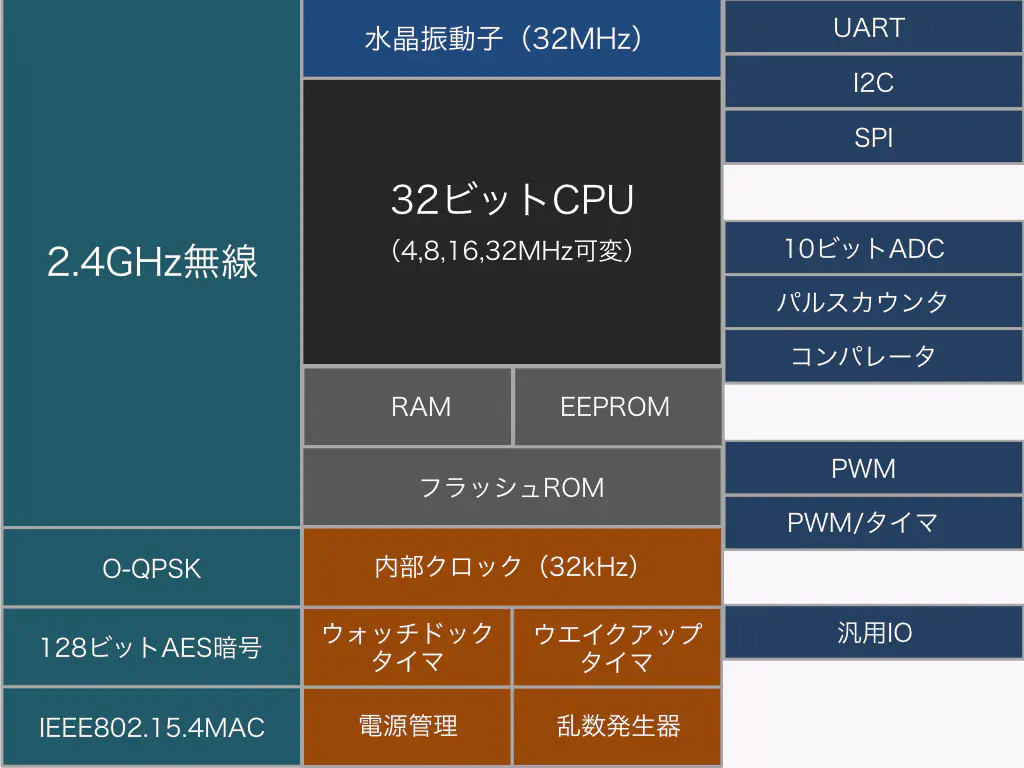
Block diagram of TWELITE DIP series
Dimensions
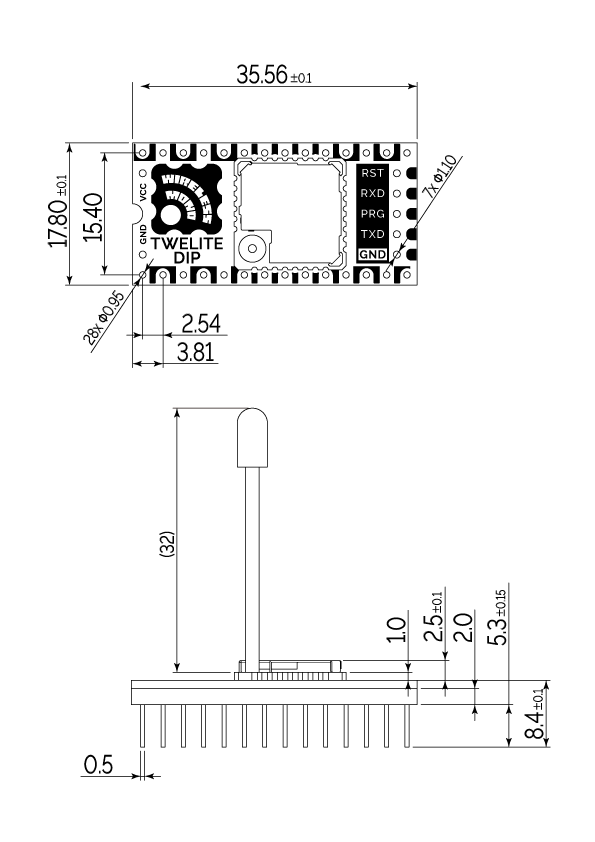
External dimensions of TWE-L-DI-W
| Dimensions | Weight | Remarks |
|---|---|---|
| 35.56mm x 17.8mm x 3.5mm | 2.2g | Excluding antenna, connector, and terminals |
Pin Assignment
Pin Number
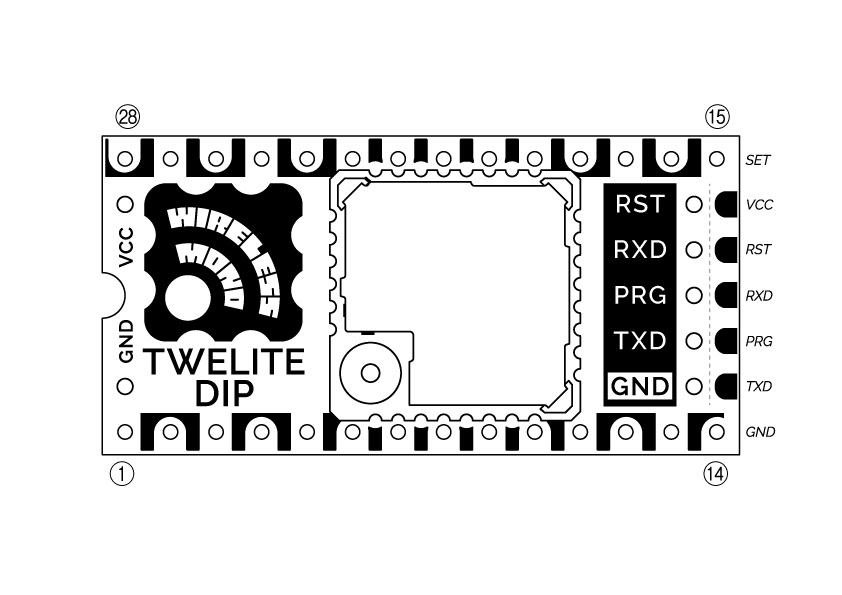
Pin Numbers and Assignments
The tail pads are compatible with the 7P interface of TWELITE R2/R3.
When soldering, be careful not to bridge the 5P through-hole next to the pad.
Pin Assignment
| #(*1) | IO Name (*2) | Function Assignment (*3) | Alternate Assignment (*4) | Feature Name in “Extremely Simple! Standard App” (*5) | ||||
|---|---|---|---|---|---|---|---|---|
| 1 | GND | GND | ||||||
| 2 | DIO14 | SIF_CLK | TXD1 | TXD0 | SPISEL1 | SCL | ||
| 3 | DIO7 | RXD0 | PWM3 | RX | ||||
| 4 | DIO5 | RTS0 | PWM1 | PC1 | PWM1 | |||
| 5 | DIO18 | SPIMOSI | DO1 | |||||
| 6 | DO0 | SPICLK | PWM2(*6) | PWM2 | ||||
| 7 | DO1 | SPIMISO | PWM3(*6) | PWM3 | ||||
| 8 | DIO19 | SPISEL0 | DO2 | |||||
| 9 | DIO4 | CTS0 | TIM0OUT | PC0 | DO3 | |||
| 10 | DIO6 | TXD0 | PWM2 | TX | ||||
| 11 | DIO8 | TIM0CK_GT | PC1 | PWM4 | PWM4 | |||
| 12 | DIO9 | TIM0CAP | 32KTALIN | RXD1 | DO4 | |||
| 13 | DIO10 | TIM0OUT | 32KTALOUT | M1 | ||||
| 14 | GND | GND | ||||||
| 15 | DIO12 | PWM2 | CTS0 | DI1 | ||||
| 16 | DIO13 | PWM3 | RTS0 | DI2 | ||||
| 17 | DIO11 | PWM1 | TXD1 | DI3 | ||||
| 18 | DIO16 | COMP1P | SIF_CLK | DI4 | ||||
| 19 | DIO15 | SIF_D | RXD1 | RXD0 | SPISEL2 | SDA | ||
| 20 | DIO17 | COMP1M | PWM4 | SIF_D | BPS | |||
| 21 | RESETN | RESETN | RST | |||||
| 22 | ADC1 | AI1 | ||||||
| 23 | DIO0 | SPISEL1 | ADC3 | AI2 | ||||
| 24 | ADC2 | VREF | AI3 | |||||
| 25 | DIO1 | SPISEL2 | ADC4 | PC0 | AI4 | |||
| 26 | DIO2 | ADC5(*7) | TIM0CK_GT | M2 | ||||
| 27 | DIO3 | ADC6(*7) | TIM0CAP | M3 | ||||
| 28 | VCC | VCC | VCC |
(*1) Pin number. The number and assignment of pins differ from TWELITE (SMD version). Usually, use the IO Name to specify pins.
(*2) Pin definition name. This is used in semiconductor datasheets and TWELITE app development; our technical support also refers to pins by their IO Name.
(*3) Each pin can be used as simple I/O or analog input, but you can assign other functions via API initialization. This table lists typical functions.
(*4) By initializing via API, you can move functions to alternate assignment pins. This table lists typical alternate functions.
(*5) Pin names specific to the “Extremely Simple! Standard App” (App_Twelite). These are similar to IO Names; take care not to confuse them.
(*6) PWM2,3 can be assigned to DO0,1 by releasing the assignment of DIO6,7 or DIO12,13.
(*7) ADC5 and ADC6 are available only on TWELITE RED.
Function Overview
| Signal Name | Function |
|---|---|
| PC | Pulse Counter |
| SPICLK | SPI Clock |
| SPISEL | SPI Select Output |
| SPIMISO | SPI Controller Input (SDI) |
| SPIMOSI | SPI Controller Output (SDO) |
| TIM0CK_GT | Timer Clock, Gate Input |
| TIM0CAP | Timer Capture Input |
| TIM0OUT | Timer PWM Output |
| 32KTALIN | Crystal Input |
| 32KTALOUT | Crystal Output |
| VREF | Reference Voltage |
| COMP1M | Comparator + Input |
| COMP1P | Comparator - Input |
| SIF_D | 2-wire Serial Data |
| SIF_CLK | 2-wire Serial Clock |
| RXD | UART RX |
| TXD | UART TX |
| RTS | UART RTS |
| CTS | UART CTS |
| PWM | Pulse Width Modulation Output |
Handling of Special Pins
DO0 (Function: SPICLK)
This pin is used as an output.
Applying voltage from external sources
(even with some output impedance) has been reported to cause the TWE module to not enter programming mode.
When connecting LEDs or transistors, the pin may enter an intermediate state upon startup or wake from sleep, potentially causing malfunction. We recommend configuring the external circuit so that it is always pulled up to Vcc.
DO1 (Function: SPIMISO)
This pin is often used as an output, but at module power-up or reset, it behaves as an input. If the voltage is judged as Low at that time, the module will start in programming mode. Pay attention to the voltage level at startup on this pin.
DIO0 (Function: ADC3), DIO1 (Function: ADC4)
These pins are shared with analog input. In firmware, the internal pull-up must be disabled when reading AD values .
ADC2
ADC2 can be used as a reference voltage input. Software implementation is required to use this. Note that there is no pin to output the reference voltage.
GND
It is recommended to connect both pins 1 and 14 to GND, but operation is possible with either unconnected. No significant change in wireless performance has been observed if one is left unconnected.
Absolute Maximum Ratings
| Min | Max | ||
|---|---|---|---|
| Power Supply (VCC) | -0.3 | 3.6 | V |
| Analog IO (VREF/ADC) | -0.3 | VCC+0.3 | V |
| Digital IO | -0.3 | VCC+0.3 | V |
Characteristics
Recommended Operating Conditions
| Symbol | Condition | min | typ | max | ||||
|---|---|---|---|---|---|---|---|---|
| Power Supply Voltage | VCC | 2.0 | 3.0 | 3.6 | V | |||
| Startup Voltage | Vboot | 2.05 | V | |||||
| Operating Temperature | TOPR | No condensation | TWELITE DIP BLUE | -40 | 25 | 105(*1) 90(*2) | ℃ | |
| TWELITE DIP RED | -30 | 25 | 90 | |||||
| Operating Humidity | HOPR | No condensation | 85 | %RH |
- Values are based on semiconductor datasheet.
*1 Max operating temperature of TWE-L-WX
*2 Max operating temperature of TWE-L-U
DC Characteristics
| Symbol | Condition | min | typ | max | |||
|---|---|---|---|---|---|---|---|
| Current Consumption | ICC | Sleep(RAMOFF, no timer) | TWELITE DIP BLUE | 0.1 | uA | ||
| TWELITE DIP RED | 0.1 | uA | |||||
| Sleep(with timer) | TWELITE DIP BLUE | 1.5 | uA | ||||
| TWELITE DIP RED | 1.5 | uA | |||||
| Transmit (CPU doze) | TWELITE DIP BLUE | 15.3 | mA | ||||
| TWELITE DIP RED | 23.3 | mA | |||||
| TWELITE DIP RED(at 3dBm output) | 14.0 | mA | |||||
| Receive (CPU doze) | TWELITE DIP BLUE | 17.0 | mA | ||||
| TWELITE DIP RED | 14.7 | mA | |||||
| Transmit Power | Pout | TWELITE DIP BLUE | +0.5 | 2.5 | dBm | ||
| TWELITE DIP RED | 9.14 | dBm | |||||
| Receiver Sensitivity | TWELITE DIP BLUE | -95 | dBm | ||||
| TWELITE DIP RED | -96 | dBm |
- Values are based on semiconductor datasheet.
I/O Characteristics
| Symbol | Condition | min | typ | max | ||
|---|---|---|---|---|---|---|
| Internal Pull-up on DIO | 40 | 50 | 60 | kΩ | ||
| DIO High Input | VIH | VCCx0.7 | VCC | V | ||
| DIO Low Input | VIL | -0.3 | VCCx0.27 | V | ||
| DIO Input Hysteresis | 200 | 310 | 400 | mV | ||
| DIO High Output | VOH | TWELITE DIP BLUE | VCCx0.8 | VCC | V | |
| TWELITE DIP RED | VCC-0.4 | |||||
| DIO Low Output | VOL | 0 | 0.4 | V | ||
| DIO Load, Sink Current | IOL | VCC 2.7~3.6V | 4 | mA | ||
| VCC 2.2~2.7V | 3 | mA | ||||
| VCC 2.0~2.2V | 2.5 | mA |
- Values are based on semiconductor datasheet.
ADC Characteristics
| Symbol | Condition | min | typ | max | ||
|---|---|---|---|---|---|---|
| Reference Voltage | VREF | 1.198 | 1.235 | 1.260 | V | |
| ADC Resolution | 10 | Bits | ||||
| ADC Integral Nonlinearity | ±1.6, ±1.8 | LSB | ||||
| ADC Differential Nonlinearity | -0.5 | 0.5 | LSB | |||
| ADC Offset Error | 0~VREF | -10 | mV | |||
| 0~2VREF | -20 | |||||
| ADC Gain Error | TWELITE DIP BLUE0~VREF | +10 | mV | |||
| TWELITE DIP BLUE0~2VREF | +20 | |||||
| TWELITE DIP RED0~VREF | -10 | |||||
| TWELITE DIP RED0~2VREF | -20 | |||||
| ADC Clock | 0.25,0.5, 1.0 | MHz | ||||
| ADC Input Range | 0.04 | VREF2xVREF | V |
- Values are based on semiconductor datasheet.
Precautions for Use
Storage
Avoid high temperature and humidity. Use the product within six months of delivery.
General Notes
Please be sure to evaluate and verify the product in your actual usage environment.
For applications requiring high reliability or involving human safety, please consult with your distributor in advance.
Revision History
| Version | Revision Date | Revision Details |
|---|---|---|
| 2.0.1 | 2024/11/12 | Corrected unit mislabeling for current consumption |
| 2.0.0 | 2024/07/12 | Updated due to PCB design change |
| 1.1.1 | 2024/03/04 | Corrected annotation in pin assignment table |
| 1.1.0 | 2024/02/27 | Migrated to new website |
| 1.0.2 | 2018/11/5 | Added explanation for Table 6 |
| 1.0.1 | 2018/3/13 | Corrected errors in pin assignment table |
| 1.0.0 | 2018/2/6 | Initial version |
2.1.2 - TWELITE DIP Wireless Microcontroller Datasheet
TWELITE DIP BLUE (Certification Model: TWE-001 Lite) / TWELITE DIP RED (Certification Model: TWELITE RED) are TWELITE modules in an easy-to-handle DIP format. They feature an ultra-low power and high-performance microcontroller, flash memory, and a high-performance IEEE802.15.4-compliant wireless transceiver.
By connecting power and sensors and storing programs in flash memory or EEPROM, the module can be operated.
Supports SPI, I2C, and UART, allowing connection to various sensors and microcontrollers.
Certified for use in Japan, making it ready for immediate productization.
Features
- Compliant with the global standard IEEE802.15.4
- Supports proprietary protocol stack “TWELITE NET”
- 28-pin (600mil) DIP IC form factor with 2.54mm pitch
- PCB design maximizes chip performance enabling stable long-range communication
- Equipped with 32KB RAM and 160KB/512KB flash memory, capable of running high-performance communication applications
- Ultra-low standby current of 0.1μA (RAMOFF sleep mode) extends battery life
- Rich I/O including 4 or 6 AD converters, 1 comparator, and 20 general-purpose I/Os allow direct connection to sensors
- Built-in flash memory allows firmware updates
- Firmware can be developed using free GNU and Eclipse-based environments
- Robust 128-bit AES encryption ensures security
- Certified under Japan’s ARIB STD-T66, no license or application required for domestic use
- RoHS compliant, meets new environmental standards
Specifications
Product Model Numbers
TWELITE DIP BLUE and TWELITE DIP RED are available in the variations shown in the table below. Please select the most appropriate one for your application.
Since sales codes may change from time to time, please refer to our website for the latest information.
| Common Name | Sales Code | Antenna | Remarks |
|---|---|---|---|
| TWELITE DIP BLUE | TWE-L-DI-W | Stick Antenna Type | Pin header mounted |
| TWE-L-DP-W | Pin header not mounted | ||
| TWE-L-DI-P | 2D Stick Antenna Type | Pin header mounted | |
| TWE-L-DP-P | Pin header not mounted | ||
| TWE-L-DI-U | Coaxial Connector Type | Pin header mounted, antenna not included | |
| TWE-L-DP-U | Pin header not mounted, antenna not included | ||
| TWELITE DIP RED | MW-R-DI-W | Stick Antenna Type | Pin header mounted |
| MW-R-DI-W | Pin header not mounted | ||
| MW-R-DI-U | Coaxial Connector Type | Pin header mounted, antenna not included | |
| MW-R-DI-U | Pin header not mounted, antenna not included |
Wireless Section
| TWELITE DIP BLUE | TWELITE DIP RED | Remarks | |
|---|---|---|---|
| Communication Method | 2.4GHzIEEE 802.15.4 compliant | 2.4GHzIEEE 802.15.4 compliant | |
| Protocol Stack | TWELITE NET andIEEE 802.15.4 MAC | TWELITE NET andIEEE 802.15.4 MAC | |
| Data Rate | Up to 250kbps | Up to 250kbps | |
| Modulation | O-QPSK, DSSS | O-QPSK, DSSS | |
| Number of Channels | 16 | 16 | May differ by country |
| Transmit Power | 2.5dBm | 9.19dBm | 25℃, 3V |
| Receiver Sensitivity | -95dBm | -96dBm | 25℃, 3V, typ |
| Transmit Current | 15.3mA | 23.3mA | 25℃, 3V, typ, max output |
| - | 14.0mA | At 3dBm output | |
| Receive Current | 17.0mA | 14.7mA | 25℃, 3V, typ |
Microcontroller Section
- 32-bit RISC processor
- Variable clock for optimized power consumption
- RAM: 32kBytes
- EEPROM: 4kBytes
- Flash memory: TWELITE DIP BLUE 160kBytes / TWELITE DIP RED 512kBytes
- Watchdog timer, brown-out detection
- Fine-grained power control for each block (digital/analog/RAM/wireless)
- Built-in AES 128bit encryption circuit, 16bit random number generator
Interfaces
| Qty | Remarks | |
|---|---|---|
| ADC | 4/6 | 10bit. TWELITE BLUE: 4 ports, TWELITE RED: 6 ports |
| PWM | 4 | |
| Timer/PWM | 1 | 5 modes including PWM, Δ∑. 16MHz, 16bit precision |
| Pulse Counter | 2 | Can operate in sleep mode. Up to 100kHz, 16bit |
| UART | 2 | 16550A compatible |
| SPIMaster/Slave | 1 | 3 chip select, up to 16MHz |
| Comparator | 1 | |
| 2-wire SerialMaster/Slave(I2C, SMBUS compatible) | 1 | Up to 100kHz or 400kHz, 7/10bit address mode |
| General-purpose Digital | 20 | Shared with other interfaces |
- Many are shared pins and may not be available depending on the combination used.
Antenna
TWE-*-W0 comes with a stick antenna, W7 comes with a question-mark type antenna.
There is also a board antenna that can be mounted on the PCB. If you wish to use it, we will provide drawings, so please contact us via the inquiry form on our website.
For TWE-*-U external antenna versions, please refer to our website.
If you wish to use antennas other than the supported types with TWELITE, separate radio certification is required. Please contact us.
Certifications
| TWELITE DIP BLUE | TWELITE DIP RED | |
|---|---|---|
| Certification Model | TWE-001 Lite | TWELITE RED |
| Technical Conformity Certification Number | 007-AB0031 | 007-AF0062 |
| FCC ID | 2AINN-L1 | - |
| IC ID | 21544-L1 | - |
| Remarks | RoHS compliant | RoHS compliant |
※1. When using TWELITE overseas, there may be various restrictions such as permitted antennas. Please consult us in the early stage of development.
※2. Depending on the country, it may be necessary to display FCC ID, IC ID, etc. on TWELITE or the product. If you think this applies, please contact us.
Notes on Export
- The built-in AES 128bit encryption circuit in TWELITE is subject to export control judgment. When exporting, we will issue an export control certificate, so please contact us.
- In some countries, customs clearance may not be possible unless TWELITE has obtained radio certification in the exporting country. Please inquire about regulations for each country.
Product Labeling
The product bears product logos, certification numbers, etc., but these may change without notice.
Block Diagram

Dimensions

| Sales Code | Dimensions | Weight | Remarks |
|---|---|---|---|
| TWE-L-DI-W/TWE-L-DP-W | 35.7mm x 17.7mm x 3.5mm | 2.2g | Excluding antenna, connector, and terminals |
| TWE-L-DI-U/TWE-L-DP-U | 35.7mm x 17.7mm x 3.5mm | 2.2g | |
| TWE-L-DI-P/TWE-L-DP-P | 47.5mm x 17.7mm x 3.5mm | 2.7g | |
| MW-R-DI-W/ MW-R -DP-W | 35.7mm x 17.7mm x 3.5mm | 2.2g | |
| MW-R-DI-U/ MW-R-DP-U | 35.7mm x 17.7mm x 3.5mm | 2.2g |
DXF data for TWE-L-DI-W outline is available for download on our website.
Pin Assignment
Pin Number

Pin Mapping
| #(*1) | IO Name (*2) | Function Assignment (*3) | Alternative Assignment (*4) | Extremely Simple! Standard App Function Name (*5) | ||||
|---|---|---|---|---|---|---|---|---|
| 1 | GND | GND | ||||||
| 2 | DIO14 | SIF_CLK | TXD1 | TXD0 | SPISEL1 | SCL | ||
| 3 | DIO7 | RXD0 | PWM3 | RX | ||||
| 4 | DIO5 | RTS0 | PWM1 | PC1 | PWM1 | |||
| 5 | DIO18 | SPIMOSI | DO1 | |||||
| 6 | DO0 | SPICLK | PWM2(*6) | PWM2 | ||||
| 7 | DO1 | SPIMISO | PWM3(*6) | PWM3 | ||||
| 8 | DIO19 | SPISEL0 | DO2 | |||||
| 9 | DIO4 | CTS0 | TIM0OUT | PC0 | DO3 | |||
| 10 | DIO6 | TXD0 | PWM2 | TX | ||||
| 11 | DIO8 | TIM0CK_GT | PC1 | PWM4 | PWM4 | |||
| 12 | DIO9 | TIM0CAP | 32KTALIN | RXD1 | DO4 | |||
| 13 | DIO10 | TIM0OUT | 32KTALOUT | M1 | ||||
| 14 | GND | GND | ||||||
| 15 | DIO12 | PWM2 | CTS0 | DI1 | ||||
| 16 | DIO13 | PWM3 | RTS0 | DI2 | ||||
| 17 | DIO11 | PWM1 | TXD1 | DI3 | ||||
| 18 | DIO16 | COMP1P | SIF_CLK | DI4 | ||||
| 19 | DIO15 | SIF_D | RXD1 | RXD0 | SPISEL2 | SDA | ||
| 20 | DIO17 | COMP1M | PWM4 | SIF_D | BPS | |||
| 21 | RESETN | RESETN | RST | |||||
| 22 | ADC1 | AI1 | ||||||
| 23 | DIO0 | SPISEL1 | ADC3 | AI2 | ||||
| 24 | ADC2 | VREF | AI3 | |||||
| 25 | DIO1 | SPISEL2 | ADC4 | PC0 | AI4 | |||
| 26 | DIO2 | ADC5(*7) | TIM0CK_GT | M2 | ||||
| 27 | DIO3 | ADC6(*7) | TIM0CAP | M3 | ||||
| 28 | VCC | VCC | VCC |
*1. Pin number. Different from TWELITE (SMD version) in numbering and assignment. Use IO Name to identify pins.
*2. IO Name is the pin’s defined name, used in semiconductor datasheets and TWELITE app development. This is also the default naming used in our technical support.
*3. Each pin can be used for general input/output or analog input, but can also be initialized via API to assign alternative functions. This column lists representative assignments.
*4. Functions listed here are available when the pin is initialized via API for alternate use.
*5. Function names specific to the “Extremely Simple! Standard App” (App_Twelite). These may resemble IO names but are distinct.
*6. PWM2 and PWM3 can be reassigned from DIO6,7 or DIO12,13 to DO0,1.
*7. ADC5 and ADC6 are available only on TWELITE RED.
Function Description
| Signal Name | Function |
|---|---|
| PC | Pulse Counter |
| SPICLK | SPI Master Clock |
| SPISEL | SPI Select Output |
| SPIMISO | SPI Master Input |
| SPIMOSI | SPI Master Output |
| TIM0CK_GT | Timer Clock, Gate Input |
| TIM0CAP | Timer Capture Input |
| TIM0OUT | Timer PWM Output |
| 32KTALIN | Crystal Input |
| 32KTALOUT | Crystal Output |
| VREF | Reference Voltage |
| COMP1M | Comparator + Input |
| COMP1P | Comparator - Input |
| SIF_D | 2-wire Serial Data |
| SIF_CLK | 2-wire Serial Clock |
| RXD | UART RX |
| TXD | UART TX |
| RTS | UART RTS |
| CTS | UART CTS |
| PWM | Pulse Width Modulation Output |
Handling of Special Pins
DO0 (Function Name: SPICLK)
This pin is used as an output pin.
Applying voltage externally
(even with some output impedance) has been reported to prevent the TWE module from entering program mode.
When connecting LEDs or transistors, the pin may be in an intermediate state at startup or when waking from sleep, causing abnormal operation. It is recommended to always use an external circuit that pulls up to Vcc.
DO1 (Function Name: SPIMISO)
This pin is often used as an output pin, but at module power-on or reset it behaves as an input. If a low voltage is detected at that time, the module starts in program mode. Please pay attention to the voltage at startup on this pin.
DIO0 (Function Name: ADC3), DIO1 (Function Name: ADC4)
These pins are shared with analog input. In firmware, internal pull-up must be disabled when reading AD values .
ADC2
ADC2 can be used as an input for reference voltage. Software implementation is required to use this. Note, there is no pin that outputs the reference voltage.
GND
It is recommended to connect both pins 1 and 14 to GND, but it is also possible to operate with one unconnected. No significant change in wireless performance has been observed even if either is left unconnected.
Absolute Maximum Ratings
| Min | Max | ||
|---|---|---|---|
| Power Supply (VCC) | -0.3 | 3.6 | V |
| Analog IO (VREF/ADC) | -0.3 | VCC+0.3 | V |
| Digital IO | -0.3 | VCC+0.3 | V |
Characteristics
Recommended Operating Conditions
| Symbol | Condition | min | typ | max | ||||
|---|---|---|---|---|---|---|---|---|
| Supply Voltage | VCC | 2.0 | 3.0 | 3.6 | V | |||
| Startup Voltage | Vboot | 2.05 | V | |||||
| Operating Temperature | TOPR | No condensation | TWELITE DIP BLUE | -40 | 25 | 105(*1) 90(*2) | ℃ | |
| TWELITE DIP RED | -30 | 25 | 90 | |||||
| Operating Humidity | HOPR | No condensation | 85 | %RH |
- Values based on semiconductor datasheet.
*1 Maximum operating temperature for TWE-L-WX/W0/W7
*2 Maximum operating temperature for TWE-L-U
DC Characteristics
| Symbol | Condition | min | typ | max | |||
|---|---|---|---|---|---|---|---|
| Current Consumption | ICC | Sleep(RAMOFF no timer) | TWELITE DIP BLUE | 0.1 | uA | ||
| TWELITE DIP RED | 0.1 | uA | |||||
| Sleep(with timer) | TWELITE DIP BLUE | 1.5 | uA | ||||
| TWELITE DIP RED | 1.5 | uA | |||||
| Tx (CPU doze) | TWELITE DIP BLUE | 15.3 | mA | ||||
| TWELITE DIP RED | 23.3 | uA | |||||
| TWELITE DIP RED(at 3dBm output) | 14.0 | uA | |||||
| Rx (CPU doze) | TWELITE DIP BLUE | 17.0 | mA | ||||
| TWELITE DIP RED | 14.7 | mA | |||||
| Transmit Power | Pout | TWELITE DIP BLUE | +0.5 | 2.5 | dBm | ||
| TWELITE DIP RED | 9.14 | dBm | |||||
| Receiver Sensitivity | TWELITE DIP BLUE | -95 | dBm | ||||
| TWELITE DIP RED | -96 | dBm |
- Values based on semiconductor datasheet.
I/O Characteristics
| Symbol | Condition | min | typ | max | ||
|---|---|---|---|---|---|---|
| DIO Internal Pull-Up | 40 | 50 | 60 | kΩ | ||
| DIO High-Level Input | VIH | VCCx0.7 | VCC | V | ||
| DIO Low-Level Input | VIL | -0.3 | VCCx0.27 | V | ||
| DIO Input Hysteresis | 200 | 310 | 400 | mV | ||
| DIO High-Level Output | VOH | TWELITE DIP BLUE | VCCx0.8 | VCC | V | |
| TWELITE DIP RED | VCC-0.4 | |||||
| DIO Low-Level Output | VOL | 0 | 0.4 | V | ||
| DIO Drive/Sink Current | IOL | VCC 2.7~3.6V | 4 | mA | ||
| VCC 2.2~2.7V | 3 | mA | ||||
| VCC 2.0~2.2V | 2.5 | mA |
- Values based on semiconductor datasheet.
ADC Characteristics
| Symbol | Condition | min | typ | max | ||
|---|---|---|---|---|---|---|
| Reference Voltage | VREF | 1.198 | 1.235 | 1.260 | V | |
| ADC Resolution | 10 | Bits | ||||
| ADC Integral Non-Linearity | ±1.6, ±1.8 | LSB | ||||
| ADC Differential Non-Linearity | -0.5 | 0.5 | LSB | |||
| ADC Offset Error | 0~VREF | -10 | mV | |||
| 0~2VREF | -20 | |||||
| ADC Gain Error | TWELITE DIP BLUE0~VREF | +10 | mV | |||
| TWELITE DIP BLUE0~2VREF | +20 | |||||
| TWELITE DIP RED0~VREF | -10 | |||||
| TWELITE DIP RED0~2VREF | -20 | |||||
| ADC Clock | 0.25,0.5, 1.0 | MHz | ||||
| ADC Input Range | 0.04 | VREF2xVREF | V |
- Values based on semiconductor datasheet.
Precautions for Use
Storage
Store in a cool, dry place. Use the product within six months of delivery.
General Notes
Please always evaluate and verify the product in your actual usage environment.
For applications requiring high reliability or involving human life, please consult with your distributor in advance.
Revision History
| Version | Date | Details of Revision |
|---|---|---|
| 1.1.1 | 2024/03/04 | Corrected notes in the pin assignment table |
| 1.1.0 | 2024/02/27 | Migrated to new site |
| 1.0.2 | 2018/11/5 | Added explanation to Table 6 |
| 1.0.1 | 2018/3/13 | Corrected errors in the pin assignment table |
| 1.0.0 | 2018/2/6 | Initial release |